Archived Water Damage Blog Posts
Basement Water Seepage: 5 Critical Causes of Damages
10/30/2023 (Permalink)
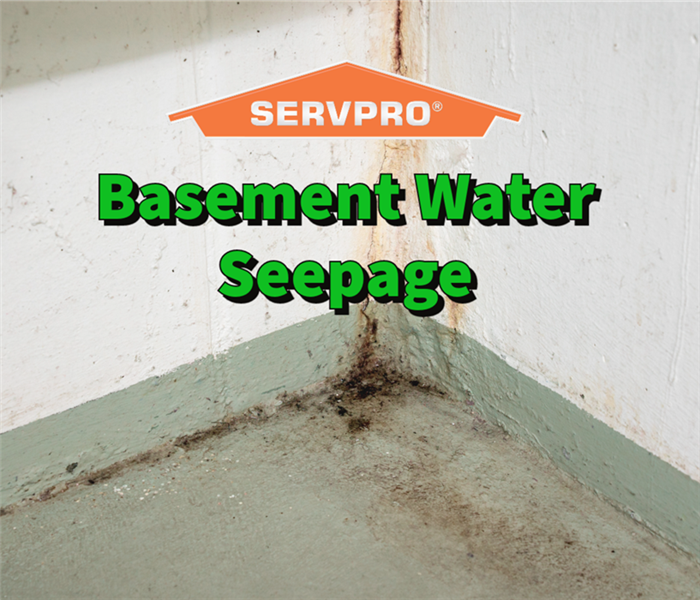 The professionals at SERVPRO can help you combat basement water seepage!
The professionals at SERVPRO can help you combat basement water seepage!
Basement water seepage can lead to severe structural damage if left unaddressed.
A basement is more than just an additional space or a storage zone in your home. It's an integral part of the structure, and keeping it in pristine condition is essential for the overall health and longevity of the entire property. One of the most common issues homeowners face in regions with fluctuating weather conditions is basement water seepage. And when left untreated, it can quickly escalate, leading to more complex problems and potential damage.
In this blog post, we'll explore the five most common causes of basement water seepage and delve into a real-life scenario from Smyrna, Georgia, where SERVPRO® was the hero. By the end, you'll know why your best decision is to choose SERVPRO for tackling your basement water seepage issues.
What is basement water seepage?
Basement water seepage refers to the unwanted entrance of water or moisture into the basement of a home or building. It's more subtle than flooding but can lead to significant structural issues, mold growth, and damage to your personal belongings over time. The main culprits for seepage are often related to the external environment or foundational issues.
Recognizing the signs of basement water seepage
Basement water seepage can be a silent adversary, discreetly wreaking havoc before homeowners even detect a problem. It's essential to remain vigilant and be aware of the warning signs to act promptly and prevent substantial damage. Here are some unmistakable signs that water is infiltrating your basement:
- Damp spots: Often seen on walls or floors, these indicate direct water penetration.
- Musty or moldy odor: A persistent stale smell hints at lingering moisture even if the basement appears dry.
- Wall discoloration or stains: Yellow or brown stains on walls, ceilings, or carpets often result from water damage.
- Peeling paint: Often a result of moisture trapped behind the paint, causing it to lose its adhesive properties.
- Warping wood: Bent or deformed wooden structures in the basement due to prolonged water exposure.
- Visible mold growth: Mold thrives in damp environments, so its presence directly points to moisture issues.
- Elevated humidity: If the basement feels more humid than the rest of the house without an apparent reason, suspect water seepage.
Observing these signs will allow you to intervene early, preventing more significant complications and potential structural damage.
5 causes of basement water seepage
The first step in treating seepage is identifying its root cause. Here are the five most common causes:
- Improper ground sloping: If the ground surrounding your home doesn't fall away from the foundation, it may lead to water pooling around the structure, eventually finding its way inside.
- Cracked foundations: Over time, foundation walls can develop cracks due to natural settling or external pressures. These cracks can allow water to seep inside.
- Inadequate drainage systems: With a proper drainage system, water might be directed away from the foundation, leading to potential seepage.
- Hydrostatic pressure: This is caused by water in the soil exerting pressure on the basement walls. When the pressure becomes too great, water can be forced through even the tiniest of cracks.
- Poorly sealed window wells: If the window wells in your basement need to be sealed properly, they can act as entry points for water during heavy rainfall.
How to stop water from seeping into the basement floor?
Prevention is always better than cure. Consider the following preventative measures:
- Ensure that the ground around your home slopes away from the foundation.
- Regularly inspect for and repair foundation cracks.
- Install a proper drainage system that directs water away from your home.
- Consider a sump pump for areas particularly prone to basement water seepage.
- Ensure window wells are properly sealed and in good condition.
Are you thinking about finishing a basement with seepage?
Before considering finishing or renovating your basement, addressing any existing water seepage problems is imperative. A finished basement with ongoing water issues can damage flooring, walls, and stored items. Moreover, damp conditions are conducive to mold growth, which poses risks.
SERVPRO to the rescue
Now, let's journey to Smyrna, Georgia. After days of continuous rain, the Thompson family noticed tell-tale signs of basement water seepage. There were damp spots on the walls, a musty odor, and pooling water near the window wells. Recognizing the potential risks, they called in the SERVPRO experts of South Cobb.
Our team, equipped with advanced tools and unmatched expertise, quickly identified the multiple entry points for water. From sealing foundation cracks to rectifying the drainage system, SERVPRO addressed the immediate issue and implemented measures to prevent future occurrences. The basement was dried, cleaned, and restored to its original state, much to the Thompson family's relief.
Why choose SERVPRO for basement water seepage services?
The Thompson family's experience in Smyrna is one of the many testimonials of SERVPRO's commitment to excellence. Here's why SERVPRO is the go-to choice for basement water seepage:
- Expertise: With years of experience, our water damage professionals are adept at identifying and rectifying the root causes of seepage.
- Advanced tools: From moisture meters to industrial-grade dehumidifiers, our team is armed with state-of-the-art equipment to tackle seepage head-on.
- Holistic solutions: We believe in addressing the issue at its root, ensuring you don't face recurring problems.
- Customer service: Your satisfaction is our priority. We provide timely service, clear communication, and a hassle-free experience.
Wrapping up
Basement water seepage might seem like a minor inconvenience initially, but if left unchecked, it can snowball into a significant concern affecting your property's structure and value. Homeowners can significantly reduce the risks by understanding its causes and implementing preventative measures. However, it's essential to turn to trusted professionals for a holistic solution when faced with seepage issues.
SERVPRO stands out as the premier choice for addressing basement water seepage concerns. With our experience, advanced tools, and commitment to customer satisfaction, you can rest assured that your home is in the best hands. Don't let seepage dampen your peace of mind; choose SERVPRO.
Mastering Summer Humidity Control: 5 Expert Tips for Comfort
6/26/2023 (Permalink)
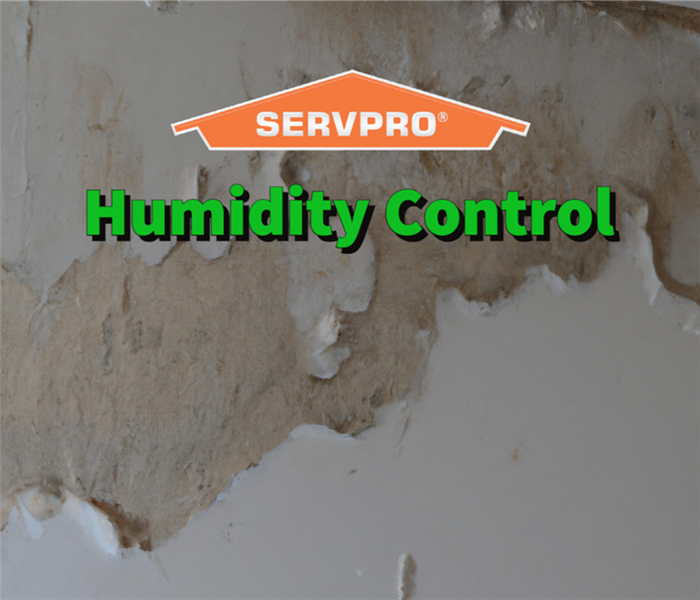 Understanding humidity control is essential for protecting your property from moisture damage.
Understanding humidity control is essential for protecting your property from moisture damage.
Understanding humidity control will ensure your property avoids unwanted moisture damage this summer.
When the summer season arrives, so does the relentless heat and oppressive humidity. As the temperature rises, so does the moisture in the air, making it challenging to maintain a comfortable indoor environment.
High humidity levels can lead to problems like mold growth, musty odors, and even moisture damage to your belongings. That's why it's crucial to take control of summer humidity and create a serene oasis within your home.
In this blog post, we will explore five essential tips to help you combat summer humidity and keep your living space cool, dry, and enjoyable.
What is humidity control?
Humidity control refers to maintaining optimal moisture levels in the air within your home during the summer months. By managing humidity, you can create a more comfortable indoor environment, prevent moisture-related problems, and improve the overall air quality.
How to test humidity levels?
Testing humidity levels in your property is essential to determine whether they are within the recommended range. Here are a couple of methods you can use to test humidity levels:
- Hygrometer: A hygrometer is the most accurate and convenient way to measure humidity. This device is specifically designed to measure and display relative humidity. There are various types of hygrometers available, including digital and analog options. Place the hygrometer in the area you want to test; it will give you an accurate reading of the humidity levels.
- Dew point calculation: Another method to estimate humidity levels is by calculating the dew point. The dew point is the temperature at which the air becomes saturated, and condensation occurs. You can use an online dew point calculator or a handheld device that measures temperature and humidity to determine the dew point. By comparing the current temperature with the dew point, you can gauge the relative humidity in the air.
By regularly testing the humidity levels in your property, you can identify potential issues and take appropriate measures to control and maintain optimal humidity for a comfortable living environment.
What are the effects of high humidity?
When humidity levels rise, moisture saturates the air, leading to several adverse consequences. Excessive humidity can cause many problems, such as condensation on windows and surfaces, musty odors, and a clammy, uncomfortable atmosphere.
Additionally, high humidity creates an ideal breeding ground for mold, mildew, and dust mites, which can thrive in damp environments. Moreover, prolonged exposure to high humidity can damage furniture, wooden structures, and electronic equipment, leading to warping, corrosion, and malfunction.
5 tips to control humidity this summer
The Environmental Protection Agency (EPA) recommends keeping indoor humidity levels between 30% and 50%. Humidity levels below 30% can lead to dry air and respiratory discomfort, while levels above 50% can promote mold growth and cause damage to furniture and other belongings. Here are some tips to help keep the humidity levels in your property in the desired range:
- Proper ventilation: Proper ventilation is vital for humidity control. Ensure your home has adequate airflow by opening windows and doors whenever possible. Utilize exhaust fans in kitchens and bathrooms to remove excess moisture. Additionally, consider installing attic and whole-house fans to promote air circulation and reduce humidity levels.
- Air conditioning and dehumidification: Air conditioning not only cools the air but also helps to dehumidify it. Set your air conditioner to the "cool" and "dry" modes to remove excess moisture from the air. If your AC unit doesn't have a dehumidification setting, consider using a standalone dehumidifier in high-humidity areas of your home.
- Seal air leaks: Air leaks can increase your home's humidity levels. Check for gaps or cracks in windows, doors, and walls, and seal them properly using weatherstripping or caulk. You can maintain a more comfortable indoor environment by preventing warm, humid air from entering your home.
- Insulate and ventilate attic spaces: Attics can trap heat and humidity, which can seep into your living areas. Proper insulation and ventilation in your attic can help regulate temperature and humidity levels. Install insulation in the attic floor and ensure adequate airflow using vents or fans. Proper ventilation will prevent hot air from affecting the rest of your home and reduce the overall humidity levels.
- Use moisture absorbers: Moisture absorbers, such as desiccants or silica gel packs, can reduce humidity in small spaces. You can place them in closets, cabinets, or other areas prone to excess moisture. These absorbers help to remove moisture from the air, preventing musty odors and minimizing the risk of mold growth.
Final thoughts
Maintaining humidity control during summer is crucial for a comfortable and healthy living environment. By implementing these expert tips, you can keep excessive moisture at bay and enjoy a comfortable, dry home. Remember, SERVPRO is always there to assist you in case of humidity and water damage. With their swift response, expertise, and comprehensive restoration services, SERVPRO ensures that your property is restored efficiently, minimizing disruptions and helping you get back to normal as soon as possible. Choose SERVPRO of South Cobb and experience the utmost professionalism and excellence in water damage restoration.
Sump Pump Leak: Identifying the 5 Signs of a Serious Problem
2/27/2023 (Permalink)
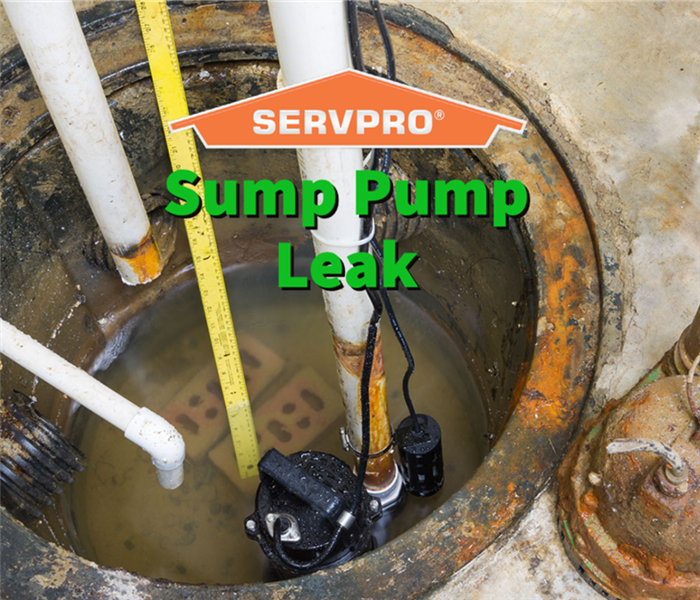 The professionals at SERVPRO are available 24/7 to help mitigate your sump pump leak!
The professionals at SERVPRO are available 24/7 to help mitigate your sump pump leak!
A sump pump leak can be a significant problem for homeowners, leading to costly repairs if not identified and addressed quickly.
The professionals at SERVPRO of South Cobb want to ensure that you combat water damage at all times of the year. Therefore, property owners must recognize signs of sump pump leakage to take proactive steps to identify sump pump problems before they worsen.
In this article, we will discuss five signs that indicate a sump pump leak at your property. These signs include soggy spots in the yard, water seeping into foundation walls, musty odors coming from inside the home, a sump pump constantly running or not working correctly, flooding in the basement or crawlspace, as well as water stains on walls and floors. So without further ado, let's dive into everything you need about sump pump leaks!
What is a sump pump, and why do they leak?
Sump pumps are designed to remove water collected in a sump basin, typically found in the lowest part of a basement or crawlspace. The sump pump then pumps the water out of the sump basin and away from the home's foundation through a discharge pipe. Sump pumps are essential for keeping basements and crawlspaces dry and can prevent flooding.
However, sump pumps can fail for various reasons, including age, improper installation, power outages, clogs or debris in the sump basin, and even freezing temperatures. These issues can lead to sump pump leakage that can cause costly damage to your home.
Five signs that indicate a sump pump leak
- Soggy spots in the yard: if you notice wet spots on your lawn that weren't there before, it could be a sign of sump pump leakage. You will want to pay attention to saturated areas near the sump basin.
- Water seeping into foundation walls: water may seep into your home's foundation walls if the sump pump leaks. Water in the foundation walls can cause various problems, including structural damage, foundation settlement, and mold growth.
- Musty odors: if a sump pump leakage has occurred, a musty smell will likely come from inside your home. A musty odor usually indicates mold and mildew growth due to soggy conditions.
- Sump pump running constantly: if your sump pump is continuously running or not working correctly, this may mean sump pump leakage. It could also signify that the sump pump is clogged with debris.
- Flooding in the basement or crawl space - If a sump pump leakage has occurred, there will likely be some flooding in the basement or crawl space. Flooding can cause costly problems, including mold growth, wet floors and walls, and even structural damage.
How the professionals at SERVPRO can help
When your property suffers from sump pump leakage, the professionals at SERVPRO of South Cobb can help. We have the knowledge and experience to identify sump pump problems and take proactive steps to repair them before they become costly repairs. We can help even if there is severe water damage! We have the tools and equipment to mitigate sump pump leakage and other water damage.
We understand how stressful sump pump issues can be, and we're here to help every step of the way. When we arrive at a sump pump leak, we will:
- Inspect the sump pump and sump basin to assess the situation and identify any sump pump problems.
- Repair the sump pump, sump basin, or discharge pipe if necessary.
- Extract any standing water from your basement or crawl space.
- Remove wet materials, including carpets and drywall.
- Use specialized equipment to dry the area and prevent mold growth.
- Replace any damaged materials.
Wrapping up
Today we reviewed sump pump leaks and the signs indicating a pump leak at your property. Signs of sump pump leakage include soggy spots in the yard, water seeping into foundation walls, musty odors coming from inside the home, sump pumps constantly running or not working correctly, flooding in the basement or crawl space, and water stains on walls or floors. Homeowners must take proactive steps to identify sump pump problems before they become costly.
When sump pump leakage occurs, the SERVPRO of South Cobb professionals can help, even if there is severe water damage. We have the tools and equipment to mitigate sump pump leakage and other water damage. So if you are experiencing sump pump problems, don't hesitate to contact us! We're here to help you every step of the way.
Water Damaged Ceiling: 4 Actionable Steps To Prevent Further Damage
9/28/2022 (Permalink)
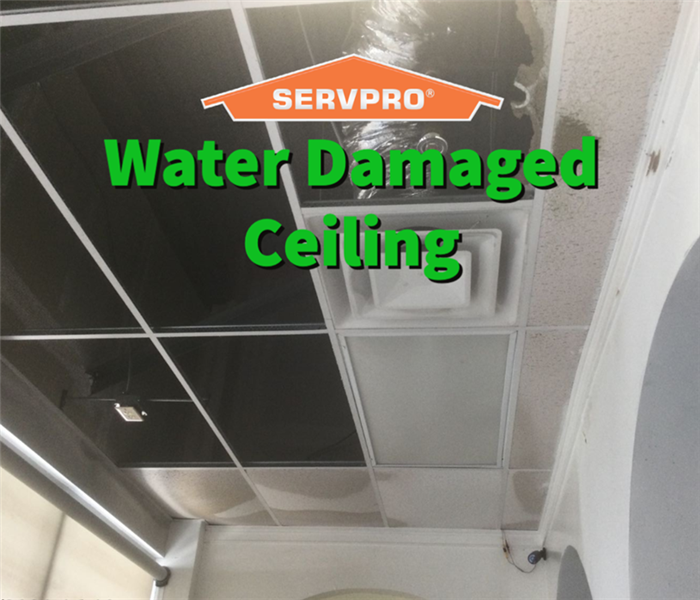 The professionals at SERVPRO are available 24/7 to help combat water damage.
The professionals at SERVPRO are available 24/7 to help combat water damage.
After discovering a water damaged ceiling in your home, it's essential to take action immediately to prevent further damage like mold growth.
No one ever said that being a homeowner was easy. In fact, it can be downright challenging at times. One of the most common problems homeowners face is water damage. Whether it's a leaky roof, a flooded basement, or water seeping in through windows and doors, water can cause severe damage to your home if not addressed promptly.
The professionals at SERVPRO of South Cobb have mitigated and restored water damaged ceilings for many homeowners in the area. Therefore, we know how important it is to take action quickly to prevent further damage like mold growth.
In this article, we'll look at four actionable steps you can take to prevent further water damage in your home after discovering a water damaged ceiling. So, if you're dealing with water damage, read on for some helpful tips.
Signs of a water damaged ceiling
Water damaged ceilings can exhibit various signs, depending on the extent and severity of the damage. Some common signs of water damage to a ceiling include:
- Stains or watermarks on the ceiling
- Peeling or bubbling paint
- A sagging or drooping ceiling
- Wet spots on the ceiling
- Mold or mildew growth
Steps to take after discovering a water damaged ceiling
If you've recently discovered water damage to your ceiling, it's essential to take action immediately to prevent further damage. Here are four steps you can take:
- Assess the damage and determine the source of the leak.
- Dry out the area and repair the damage.
- Monitor the area for any further signs of water damage or mold growth.
- Take steps to prevent future water damage.
Assessing the damage
The first step in dealing with a water damaged ceiling is assessing it; you want to determine its extensiveness and what caused it. Once you know the source of the leak, you can start taking steps to address it and prevent further water damage from occurring.
Drying out the area and repairing the damage
Once you've assessed the damage, it's time to start drying out the area and repairing the damage. Common repairs include:
- Repairing water-logged ceilings.
- Replacing water-damaged insulation.
- Fixing broken pipes
- Fixing leaks in roofs or walls.
It is best to call in a professional water restoration company to help get the job done right the first time.
Monitoring for water damage and mold growth
Once you've addressed the water damaged ceiling, monitoring the area for any signs of further water damage or mold growth is essential. Therefore, you will want to check for wet spots on the ceiling, watermarks or stains, peeling or bubbling paint, or sagging or drooping ceilings. Let your restoration contractor know if you notice any signs of further damage.
Preventing future water damage
In addition to monitoring for water damage and mold growth, it's essential to take steps to prevent future water damage in your home. Preventing future water damages may include:
- Installing gutter guards.
- Trimming trees and branches around your property
- Installing a sump pump if you have a basement.
Let SERVPRO of South Cobb repair your water damaged ceiling.
As we mentioned earlier, finding a reliable restoration contractor who can quickly and accurately repair your water damaged ceiling is essential. The professionals at SERVPRO of South Cobb are experienced in water damage restoration and can help get your ceiling back to its original condition. In addition, our professionals have undergone IICRC water restoration training and have the necessary equipment to properly dry out your water damaged ceiling and repair any damage.
When you choose to hire us, we will:
- Assess the water damage and create a mitigation and restoration plan.
- Use industrial-strength fans and dehumidifiers to dry out the area.
- Repair or replace any water damaged ceilings, insulation, or other water-logged materials.
- Monitor the area for mold growth.
- Take steps to prevent future water damage in your home.
Please don't hesitate to contact us if you have any questions or would like to schedule a time for us to come out and assess your water damaged ceiling. We are available 24/7 and will be there when you need us most.
High Water Table: The 5 Ways Your Property Can Be Affected
7/13/2022 (Permalink)
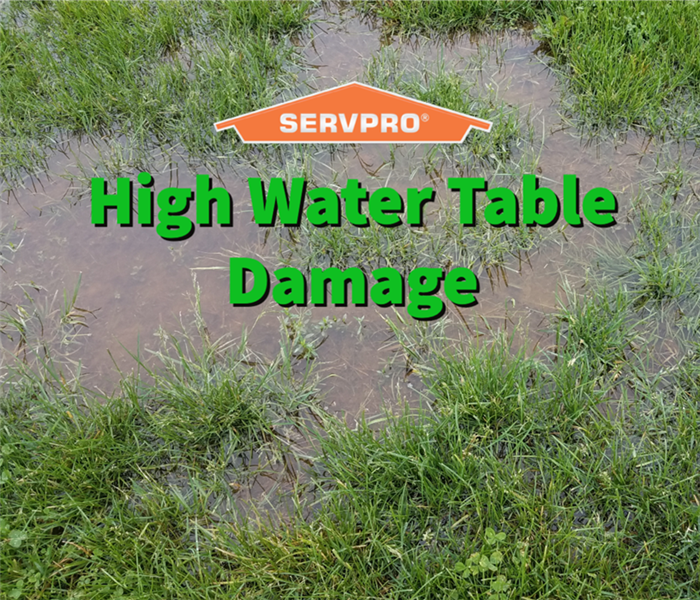 The professionals at SERVPRO are available 24/7 for emergency water damage services!
The professionals at SERVPRO are available 24/7 for emergency water damage services!
High water tables are a common problem for property owners in Georgia.
The professionals at SERVPRO of South Cobb have recently received numerous water damage calls caused by high water tables. Therefore, we put this blog post together to help customers facing similar problems with their properties.
Knowing how they affect your property is essential if you live in an area prone to high water tables. This blog post will discuss five ways a high water table can cause water damage. Keep reading for more information.
What is a water table?
A water table is an upper level to which water will naturally rise in an unconfined aquifer. The water table is important because it's the source of groundwater. When the water table is high, there's a lot of water in the ground leading to problems for property owners.
Signs of a high water table
If you're experiencing water damage and aren't sure if it's related to a high water table, there are a few ways to determine if that's the case. Here are three methods:
- Look at your property's elevation map: If you have an elevation map, you can use it to see if it is in an area prone to high water tables. If you don't have an elevation map, you can find one online or at your local zoning office.
- Check for water in your basement or crawl space: If you have a basement or crawl space, water damage will be more likely to occur if the water table is high. Water can enter through cracks in the foundation or walls, causing severe damage.
- Look for saturated areas on your property: If there are any low-lying areas on your property that are constantly wet or have standing water, it could be a sign of a high water table.
The five ways high water tables can cause damage
Now that we've gone over what a water table is and how to tell if you have a high one, let's discuss the five ways high water tables can damage a property.
1) Flooding
Flooding is the most obvious way high water tables can cause damage. If the water table is high, there's a greater chance that your property will experience flooding. Flooding can damage your home's foundation, ruin personal belongings, and lead to mold growth.
2) Basement leaks
High water tables can also cause basement leaks. If the water table is high, water can seep through cracks in the foundation and walls, causing leaks. These leaks can damage the structure of your home and lead to mold growth.
3) Soil erosion
When the water table is high, it can cause soil erosion. Soil erosion is when the water washes away the soil around your property, causing the foundation to become unstable, leading to severe damage to your home.
4) Septic tank problems
High water tables can also cause septic tank problems. If the water table is high, it can pressure the septic tank, causing it to leak or even collapse.
5) Humidity issues
High water tables can also cause humidity issues. When the water table is high, it can increase the humidity in your home, leading to mold and mildew growth.
What to do if you experience water damage caused by a high water table?
Taking immediate action is essential if you experience water damage caused by a high water table. Here are five steps you should take:
Step 1. Contact a professional
If you're experiencing water damage, it's essential to contact a professional right away. The proper professional can assess the damage and recommend the best course of action.
Step 2. Stop the water source
If you can identify the source of the water, it's essential to stop it immediately. Identifying the source will help prevent further damage.
Step 3. Remove the water
Once you've stopped the water source, you'll need to remove the water from your property.
Step 4. Dry the area
Once you've removed the water, you'll need to dry the area as soon as possible. Restoration technology like dehumidifiers and air movers is the best way to dry wet property thoroughly.
Step 5. Clean and disinfect the area
Once the area is dry, it's essential to clean and disinfect it to prevent mold and mildew growth.
High water tables can cause a lot of damage to your property, and these steps can help prevent further damage and keep your property in good condition.
How SERVPRO of South Cobb can help
We hope you enjoyed learning about high water tables and found the information provided in this blog post helpful. If you are dealing with water damage caused by a high water table, SERVPRO of South Cobb is here to help. We're a professional water damage restoration company with the certifications and experience to get the job done right. When you choose to contact us for water damage services, we will:
- Assess the damage and recommend the best course of action
- Stop the water source.
- Remove the water
- Dry the area
- Clean and disinfect the area.
We understand how overwhelming it can be to deal with water damage. That's why we're available 24/7, so don't hesitate to contact us. We're always here to help!
The Top 5 Causes of Crawl Space Water Damage
6/22/2022 (Permalink)
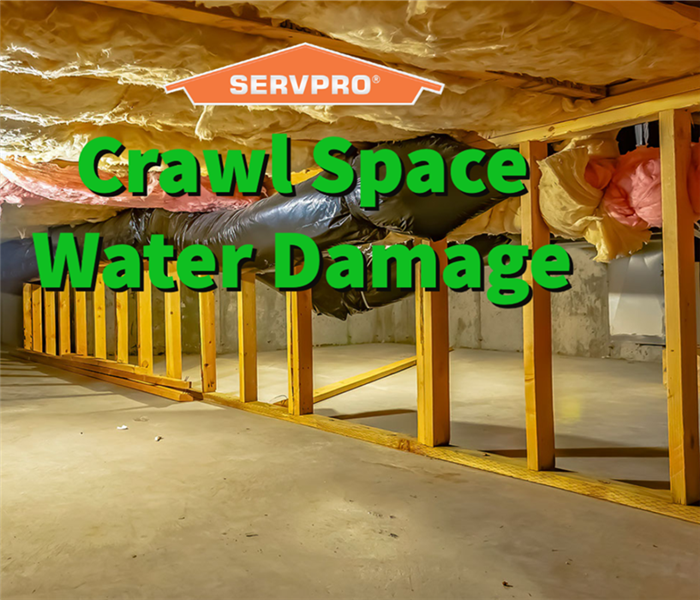 Contact the professionals at SERVPRO for fast water restoration services!
Contact the professionals at SERVPRO for fast water restoration services!
Standing water in your crawl space is not only a nuisance, but it can also lead to severe structural damage.
Most homeowners don't think about their crawl space until there's a problem. And by that time, it's often too late. Crawl space water damage can cause severe problems for homeowners, from structural damage to mold growth.
The professionals at SERVPRO of South Cobb have mitigated crawl space water damage caused by countless reasons, but here are the top five:
- Roof leaks
- Plumbing leaks
- Overflowing gutters
- Grading issues
- Foundation cracks
This blog post will detail these five most common causes of crawl space water damage. We'll also provide some tips on handling standing water in your crawl space and preventing future damage.
What is crawl space water damage?
Crawl space water damage is damage that occurs when water enters the crawl space of a home and causes damage to the structure and contents. The crawl space is the area between the ground and the first floor of a house. It is common for a crawl space to store HVAC systems, plumbing, and electrical wiring. Therefore, a property owner will want to mitigate crawl space water damage as soon as possible to prevent further damage.
The five most common causes of crawl space water damage
Now that you know more about crawl space water damage, let's look at the five most common causes:
1. Roof leaks
A roof leak is one of the most common causes of crawl space water damage. If your home has an old or damaged roof, it's more susceptible to leaks. Water can enter through holes or cracks in the roof when it rains and drips down into the crawl space. To prevent crawl space water damage from a roof leak, have your roof inspected regularly and repaired or replaced as needed.
2. Plumbing leaks
Leaking pipes can also cause crawl space water damage. If a pipe in your crawl space leaks, the water will seep into the surrounding soil and may eventually find its way into your crawl space. To prevent crawl space water damage from a plumbing leak, have your crawl space inspected regularly and any leaks repaired immediately.
3. Overflowing gutters
Another common cause of crawl space water damage is overflowing gutters. If your gutters are not properly cleaned and maintained, they can become clogged with leaves and debris. When it rains, the water will overflow from the gutters and run down the side of your house. If the gutters are improperly installed, the water can pool near your foundation and eventually find its way into your crawl space. To prevent crawl space water damage from overflowing gutters, clean your gutters regularly and make sure they are correctly installed.
4. Grading issues
Grading is the process of designing slopes and hills around your home to prevent pooling near the foundation. However, if the grading around your home is improper, water can pool near the foundation and eventually find its way into your crawl space. To prevent crawl space water damage from improper grading, inspect the grading around your home regularly and correct it as needed.
5. Foundation cracks
Foundation cracks are another common cause of crawl space water damage. If there are cracks in your foundation, water can enter your crawl space and cause damage. To prevent crawl space water damage from foundation cracks, have your foundation inspected regularly and repaired as needed.
Tips for dealing with standing water in your crawl space
If you find standing water in your crawl space, take these steps to dry it out and prevent further damage:
Tip 1) Remove any standing water
If there is standing water in your crawl space, remove it as soon as possible. The longer the water sits, the more damage it can cause.
Tip 2) Inspect for leaks.
Once the water is extracted, inspect your crawl space for leaks. Look for cracks in the foundation, holes in the roof, or any other openings where water could have entered.
Tip 3) Repair any leaks.
If you find any leaks, repair them immediately to prevent further damage.
Tip 4) Dry out the crawl space.
Once all the leaks are repaired, dry out the crawl space as much as possible. A professional restoration company like SERVPRO of South Cobb will strategically place industrial fans and dehumidifiers to dry the crawl space and prevent mold and mildew growth.
Preventing future crawl space water damage
To prevent future crawl space water damage, inspect your crawl space regularly and ensure any leaks are repaired immediately. You should also clean your gutters regularly and ensure they are correctly installed. If you live in an area with a high water table, you may consider installing a sump pump to remove any water entering your crawl space.
These steps can prevent crawl space water damage and keep your home in good condition.
How SERPVRO of South Cobb can help with crawl space water damage
We hope you enjoyed learning about crawl space water damage. If your crawl space has been damaged by water, SERVPRO of South Cobb can help. We are a professional water damage restoration company with the training and experience to dry out your crawl space and prevent mold and mildew growth.
As an IICRC-certified firm, we know the importance of working quickly to minimize the damage and get your home back to normal. So please feel free to contact us at any time for all your water damage needs. We're always here to help!
Dishwasher Water Damage: The #1 Worst Kitchen Nightmare
2/16/2022 (Permalink)
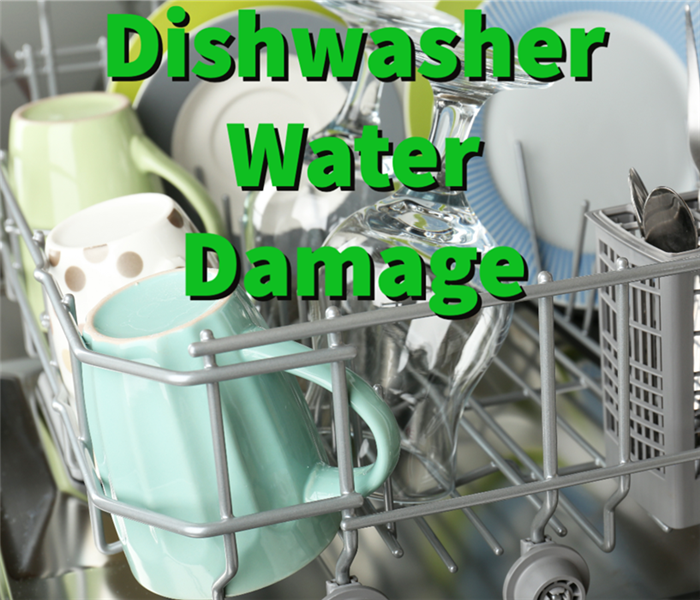 Contact the water restoration professionals at SERVPRO for 24/7 services!
Contact the water restoration professionals at SERVPRO for 24/7 services!
Dishwasher water damage is a leading cause of disasters in the kitchen.
If you've ever had dishwasher water damage in your home, you know that it can be one of the most devastating plumbing disasters to navigate through. Unfortunately, a property owner will have a short amount of time to find a reliable restoration contractor and submit a home insurance claim.
Dishwashers use hot water and pressure, which can easily break the protective coating on connecting pipes and lead to leaks. If left untreated, dishwasher water damage can cause extensive structural damage to your home and cost you thousands of dollars in repairs. In the following article, we will discuss a recent dishwasher water damage call and what you can do to prevent it from happening in your home.
The real issue with dishwashers is that a leak can occur in the process of cleaning your dishes. Leaks are common anytime you combine gallons of water with heat and pressure. Leaks from a dishwasher can be detrimental to your home and significantly impact your household.
A recent call
Early last month, the professionals at SERVPRO of South Cobb received a call from a customer after finding a large leak underneath their dishwasher. After receiving the call, we immediately dispatched a team of technicians to the scene, who quickly found extensive water damage in the customer's home that required mold remediation, drywall demolition, and comprehensive drying techniques to minimize the spread of any potential water and mold contamination.
After a thorough inspection, it was clear that the homeowner could have avoided the mold issue with an earlier call. We asked the customer how long the leak had been occurring. The homeowner responded, "the dishwasher is over 30 years old and had been leaking for about a month, most likely due to a faulty dishwasher drain line".
Our crews worked around the clock to ensure that the dishwasher water damage was adequately mitigated. Within a week after the site inspection, our professionals completed the necessary repairs and replacements to ensure that the home was safe for habitation.
If you've ever had dishwasher water damage in your home, chances are it was because you didn't maintain your dishwasher correctly. The elements inside a dishwasher can be extremely corrosive, and over time they can eat through the protective coating on your plumbing. So it's essential to have a plumber come out and inspect your home's plumbing every few years to ensure that you don't have any leaks, even if you think that everything is working as it should.
What homeowners can do to prevent dishwasher water damage
A homeowner can try to prevent any dishwasher water damage from occurring by regularly maintaining their dishwashers. Dishwashers contain corrosive substances, so you must check your home's plumbing periodically and look for rust or corrosion on the pipes connected to the dishwasher. If you notice any leaks around the base of your dishwasher, a clog in your drain line, or any other problems with your dishwasher pipes, contact a plumbing professional ASAP to prevent extensive water damage to your home.
When to contact SERVPRO
If you have already had dishwasher water damage in your home and need help from a professional restoration company, don't hesitate to give us a call. SERVPRO of South Cobb specializes in emergency water damage restoration. We have the equipment, experience, and expertise to restore your home to normal after it has experienced severe flooding or major leaks.
For emergency water removal services or more information on how you can prevent dishwasher water damage from happening, contact the IICRC certified experts at SERVPRO of South Cobb today.
Ice Dam Damage: 3 Great Tips To Prevent Ice Dams Damage
1/12/2022 (Permalink)
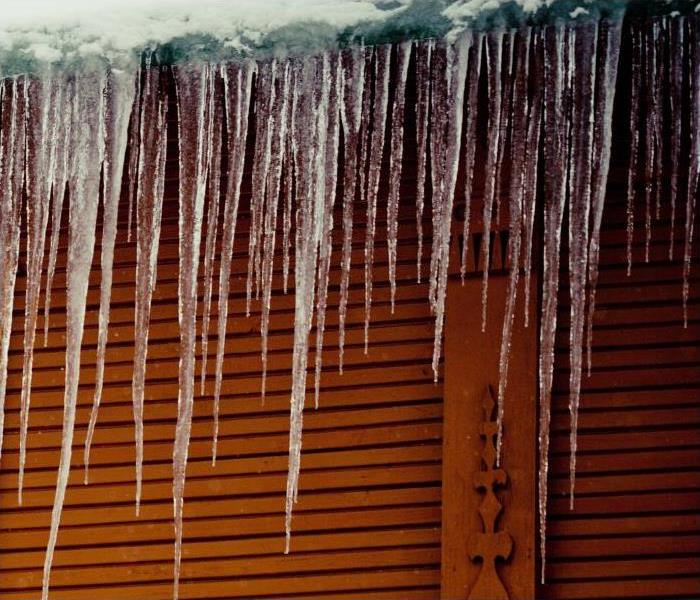 Contact the professionals at SERVPRO for emergency water damage services!
Contact the professionals at SERVPRO for emergency water damage services!
Ice dam damage is a widespread problem during the cold winter months.
The end of the winter season is still a few months away. Meaning, homeowners should be cautious about common water damage disasters in the winter months.
One of the number one causes of water damages in the wintertime is ice dams. Ice dam damage will be apparent when a homeowner notices water leaks into their home from or near an area where ice and snow have accumulated.
The professionals at SERVPRO of South Cobb understand that ice dams are a common occurrence during the winter, and if not dealt with quickly, can cause significant water damage to a home. In this blog post, we will be going over what an ice dam is and give you three great tips to help prevent ice dams from forming and causing any damage.
What is an ice dam?
An ice dam is a ridge of ice that forms at the roof's edge, generally along the gutters. The snow melting creates the ice dam on the roof, which refreezes, forming a thicker and harder ice ridge.
How do ice dams cause water damage?
Roof leaks occur when water accumulates behind the ice dam and leaks into the property. It is common for an ice dam leak to cause extensive water damage. The water can damage ceilings, walls, insulation, and electrical systems. Therefore, it is essential to take action quickly if you notice water leaking into your home or near an area where ice and snow have accumulated.
Three tips to prevent ice dams from forming and causing any damage
Water damage is the number consequence of an ice dam, and there are three main ways to prevent ice dams from forming and causing water damage to your home:
Tip 1: Keep gutters clear
To keep ice dams from accumulating onto the roof, you will want to ensure that your gutters are clean, open, and able to carry water off the roof quickly. Also, make sure all downspouts are draining properly and not clogged by leaves or other debris.
Tip 2: Ensure proper roof ventilation
Proper ventilation is a great way to prevent ice dams from forming. In addition, by allowing the roof to vent, you will keep the roof cold, and any snow melting should escape quickly. To accomplish this, do not block any roof vents.
Tip 3: Install heat cables
One of the best ways to prevent an ice dam from forming is to keep the snow off the roof. If snow cannot collect on the roof, it can't melt and create an ice dam.
Heat cables are a great option if you want to ensure that your roof is kept as snow and ice-free as possible. The heat from the cables will keep the roof's surface from ever reaching freezing temperatures, which would prevent snow and ice from accumulating on it.
SERVPRO ice dam damage restoration
We hope you enjoyed learning about ice dams and what you can do to prevent them from causing any damage.
If you notice that water is leaking into your house from or near an area where ice and snow have accumulated, call the experts at SERVPRO of South Cobb right away for fast water removal services. We will restore your property to pre-damage condition using our extensive knowledge and skills.
SERVPRO of South Cobb is a professional water damage restoration company that can help homeowners with their restoration needs. We understand the importance of acting quickly when a customer notices water leaking into their home.
If you require water damage restoration services, please contact us today. We are IICRC certified and available 24/7, 365 days a year, to help!
4 Great Reasons Why A Dryer Is Leaking Water
12/29/2021 (Permalink)
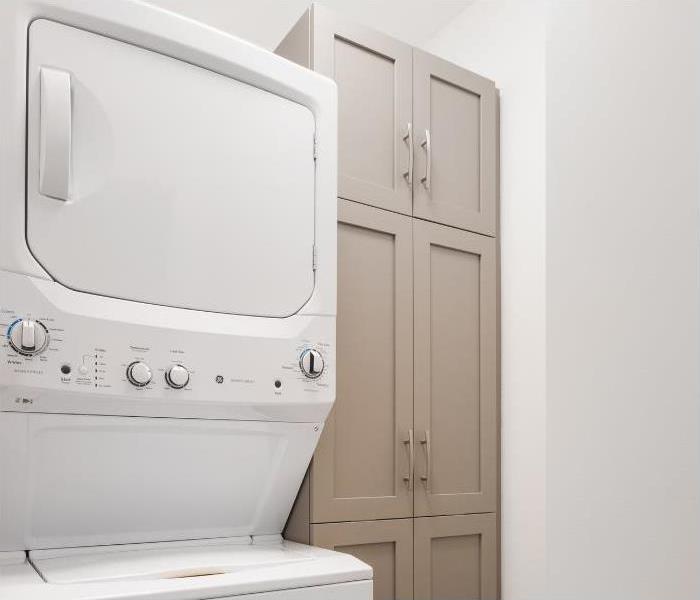 Contact the professionals at SERVPRO for quality water mitigation services!
Contact the professionals at SERVPRO for quality water mitigation services!
Most common household dryers will last for ten years or more.
The professionals at SERVPRO of South Cobb receive hundreds of water damage calls each year, and a dryer leaking water always causes a few. For example, a leaky dryer can leave leaks around the door seals and puddles on the floor surrounding the dryer.
The following blog post will cover four causes of dryer leaks. Be sure to read until the end to find out how the professionals at SERVPRO help property owners combat water damage and restore a property to its pre-disaster condition.
How to detect a dryer leak?
The best way to detect a dryer water leak will be through a quick water damage assessment:
- Visually check for puddling
- The smell of musty odors
- Listen for any strange noises
- Utilize a moisture meter to check the drywall surrounding the dryer
Any dryer that malfunctions can cause water damage to your home's sheetrock, flooring, and drywall surrounding the dryer.
Dryer leaking water cause #1 - Stacked washer & dryer malfunction
It is common for property owners with a stacked washer and dryer system to believe that their dryer is leaking when in fact, it is the washer that is causing the leak. Washing machine leaks can be caused when the stacked washer and dryer are not level.
A stacked washer and dryer can also cause water damage when the washer has a faulty connection to the dryer or plumbing piping.
Dryer leaking water cause #2 - A damaged seal on the dryer door
A dryer drum can't correctly dry clothes if not sealed well around the dryer door. A dryer leak is often caused when a dryer has a damaged dryer door seal.
Dryer leaking water cause #3 - Blocked vent pipe
A dryer works by heating air and directing it into your dryer drum where your clothes are. The heated air absorbs moisture from the load and then leaves through a vent pipe. The vent pipe is designed to help a dryer breathe by directing the dry air through a dryer vent and out of your home.
The airflow will be restricted when the vent pipe connected to your dryer becomes blocked with lint buildup. When the airflow is restricted, the dryer will not expel heated air causing moist air to collect and condense inside the dryer.
If the airflow in your vent pipe is being blocked, you should consider calling the professionals at SERVPRO to come and clear out your duct vent pipe and clean up any standing water damage.
Dryer leaking water cause #4 - Defective vent cover
A dryer vent cover is what helps dryer vent air escape your home and keep rain, animals, and leaves from entering the vent pipe. However, when the cover becomes defective, it may allow rainwater to enter the ventilation pipe and cause a water leak.
A quick inspection is the best way to check if the vent cover is defective. If you notice that the vent cover is defective, you should replace it.
Wrapping up
We hope you enjoyed learning about dryer water leaks and their common causes. We understand how much stress and time will affect a homeowner's normal routine when their property has water damage. Our professionals want to help; we can make the disastrous situation easier to bear by quickly responding and drying out any standing water.
Our professionals at SERVPRO of South Cobb will come to your water-damaged property equipped with state-of-the-art equipment and several restoration drying techniques taught by the IICRC. There is no water damage disaster that we can't dry out and restore to its pre-disaster condition.
Contact us today for 24/7 emergency services or more information.
The 5 Main Causes of a Leak Under The Kitchen Sink
10/20/2021 (Permalink)
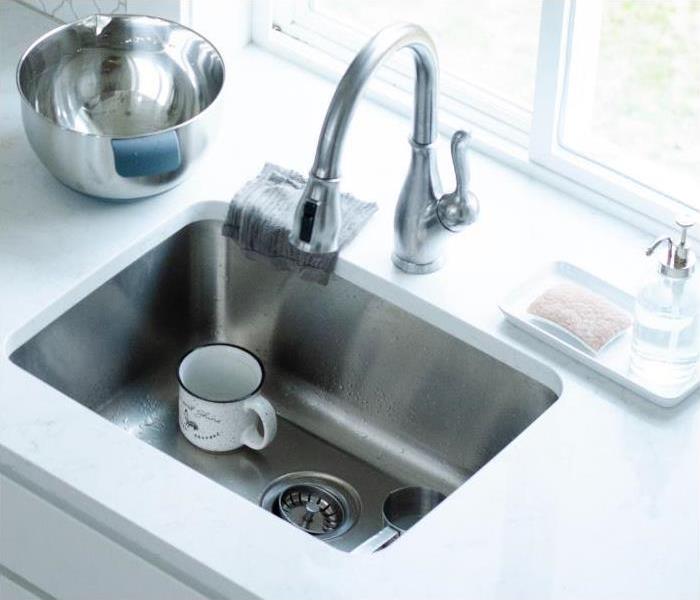 Contact the water damage restoration professionals at SERVPRO for 24/7 emergency services!
Contact the water damage restoration professionals at SERVPRO for 24/7 emergency services!
A small leak under the kitchen sink can result in severe damages when not caught in time.
The most common service call that the professionals at SERVPRO of South Cobb receive involves water damage. Water damage comes without warning and can cause thousands of dollars worth of property damage. In the following blog post, we will go over the five most common causes of water damages caused by kitchen sinks.
By the end of this blog post, we hope you understand how to prevent a kitchen sink leak by knowing the causes and taking the preventive measures listed at the end of this post.
Understanding the sign of kitchen sink water damage
A kitchen sink leak can go unnoticed for a long time and become an extensive leak that causes a magnitude of damages. People need to know the signs of a kitchen sink leak. The most common signs include:
- Mud trails in the below kitchen cabinets
- Discoloration on the ceiling below the leak
- Any dampness in the area near the kitchen sink
The 5 Main Causes Of Leak Under The Kitchen Sink
The professionals at SERVPRO of South Cobb have mitigated and restored hundreds of kitchen sink water damages, and the following are the five most common causes for a leak under the kitchen sink.
1) Clogged sink trap
A clogged sink trap can cause water to back up and overflow. A sink trap sits between your sink and drain pipe preventing any large scraps or debris from flowing down into the drain. A leak can happen if debris clogs up your sink trap or if it's just full of hard water deposits that have never been cleaned out.
2) Faucet leak
A faucet leak can cause a leak under the kitchen sink if water is constantly flowing from it. The leak can be caused by a crack in the faucet or a loose handle that isn't clamping down to stop the water flow.
3) Drain leak
A drain leak can be another reason for the leak under a kitchen sink. A leak can happen if water is constantly flowing down through your drain piping and coming back up through any of the connections in the drain. Drain leaks can also come from faulty caulking around the drain pipes.
4) Cracked pipes
Any cracked kitchen sink pipes can leak water if it's not dealt with promptly.
5) Corroded washers
Corroded washers are the final reason for a leak under your kitchen sink. Worn-out washers are one of the causes of a leak that can be prevented by changing out the washers every few years to prevent them from rusting or wearing out.
Prevention tips for kitchen sink leaks
Now that you know what causes leaks under the kitchen sink let's go over some prevention tips to keep it from happening.
- Avoid clogged kitchen sink traps by having your drains cleaned regularly or at least once a year. You should also remove any large debris from your sink before letting the water run down the drain.
- Check the handles on your faucets for loose fittings. Tighten up any loose faucet handles by turning them clockwise and ensuring the handle is secure to shut off the water flow.
- Keep an eye on any corroded washers and pipes and replace them before they start to leak.
Final thoughts
We hope that this blog post has taught you how to identify and prevent leaks under the kitchen sink to save yourself some time, money, and hassle. For more tips on leak prevention or mitigation information, be sure to check out our blog.
SERVPRO of South Cobb is a locally-owned and operated restoration company with the training and experience to assist you with any size water damage disaster. Our technicians are certified by the Institute of Inspection, Cleaning and Restoration Certification (IICRC) in water damage mitigation, construction drying, fire restoration, carpet cleaning, upholstery cleaning, tile & grout cleaning service, air duct cleaning, mold remediation, and biohazard cleanup.
Call the number above or click here to fill out a contact form today. We'll get in touch with you as soon as possible to schedule an appointment at your convenience.
Appliance Leak: Top 5 Appliances that Cause Water Damage
8/11/2021 (Permalink)
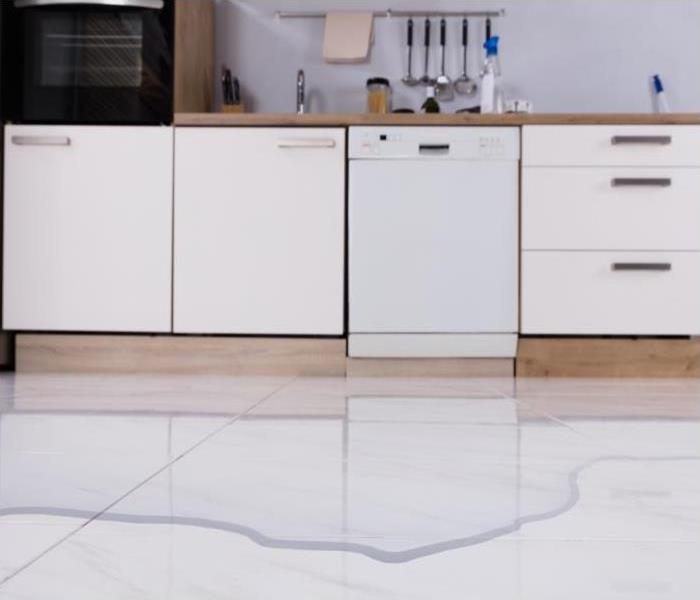 Contact the water damage restorers at SERVPRO today!
Contact the water damage restorers at SERVPRO today!
An appliance leak can cause serious issues for homeowners.
If you are reading this, there is a very good chance that you have recently experienced appliance leak damage to your property. The professionals at SERVPRO of South Cobb have first-hand mitigated and restored major water damages caused by appliance leaks.
If you suspect an appliance leak has caused your property's water damage, then it is important to know what appliance is responsible. In this blog post, we will be discussing appliance leaks and the five most common appliances that cause water damage.
Real-world scenario
In the past, the team at SERVPRO of South Cobb has received calls for water restoration services after a homeowner finds that their property has water damage from an appliance leak. The most common culprit of these water damages is a leaking refrigerator. A refrigerator leak may cause damage to the kitchen and basement flooding.
When water damage is left to sit for a long period, our professionals will commonly find mold damage throughout the property. Fortunately, when a customer chooses to call us for services, we quickly dry out their property and rebuild. In the end, a homeowner will receive a new dream kitchen remodel and a property that was free of mold damage.
Which appliances are at the greatest risk for leaking?
The most common cause of an appliance leak is the result of age or overuse. But, as well, an appliance leak can occur when the appliance's water supply line is incorrectly installed.
How to avoid appliance leaks?
Appliance leaks are preventable through regular maintenance and subsequent repair of any damage that may have occurred to the appliance. If you believe that your appliance is malfunctioning, then it is best to shut off the power to the appliance and call the manufacturer of the appliance for repairs.
The top 5 appliances that cause water damage
As you have already learned, an appliance leak can lead to costly repairs and even major damages like mold infestation when not addressed quickly. The following list includes the top five appliances that the SERVPRO professionals have found to cause water damage:
- Dishwasher leaks
- Refrigerator leaks
- Washing machine leaks
- Air conditioner leaks
- Water fountain leaks
What to do when you find an appliance leak?
No matter the size of the appliance leak, you will want to contact a reputable appliance repair company to come out and take a look at the malfunctioning appliance.
The appliance repair company will first try and determine the cause of the leak. Once they've identified what's wrong with the malfunctioning appliance, they can give you an estimate for how much repairs are going to cost.
If severe damages are done to the property from the leaking appliance, you will want to contact a water damage restoration company.
Why call SERVPRO?
When a property has water damage caused by an appliance leak, you will want to call the professionals at SERVPRO of South Cobb as soon as possible. SERVPRO of South Cobb is a highly reputable water restoration company located in Austell, Georgia.
When you choose to call SERVPRO for disaster restoration services, you will receive a team of IICRC certified professionals with experience handling any size of water damage. We take pride in our ability to deliver fast services without compromising quality.
SERVPRO of South Cobb is fully equipped with advanced water extraction equipment, air scrubbers, and dehumidifiers to ensure a property dried out in the fastest amount of time possible.
Please contact us today for any further questions on how we can help you restore your appliance leak "Like it never even happened."
3 Tips for Quickly Repairing Water Damaged Hardwood Floors
7/21/2021 (Permalink)
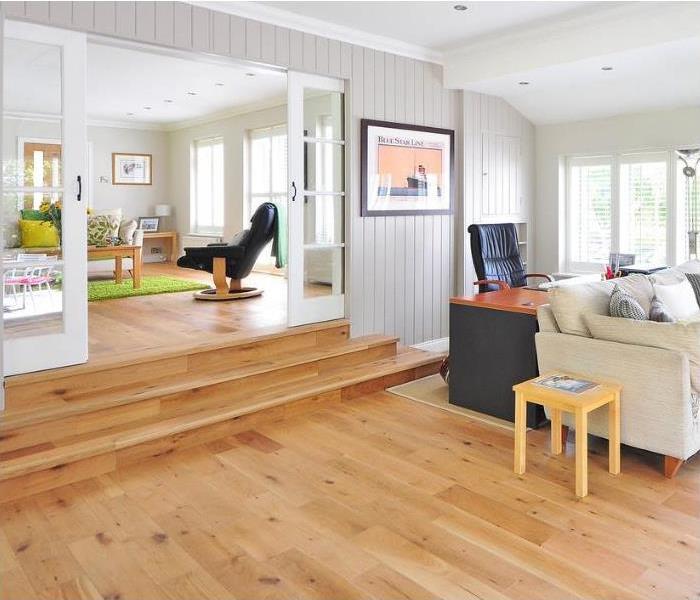 SERVPRO offers hardwood floor water damage restoration!
SERVPRO offers hardwood floor water damage restoration!
A property with hardwood flooring is never safe from water damage.
Water damage can be a devastating event for any homeowner. Not only does water damage create an unpleasant environment, but it also means that water has damaged your hardwood floors. The good news is there are some simple steps you can take to repair water-damaged hardwood floors and get them looking like new again! In this blog post, we will go over the top 3 tips for quickly repairing water-damaged hardwood floors.
Causes of hardwood floor water damage
It is unfortunate that water damage can happen to anyone and will be very disappointing when it damages beautiful hardwood floors. When excess water gets on your hardwood floors, it will create water stains and possibly warp the wood. Hardwood water restoration is a challenging project that requires special care to save the hardwood flooring from having to be removed.
The most common causes of hardwood flooring water damage will result from pipe bursts or appliance leaks. These water-related problems can be difficult to detect and may not happen right away. It is best to check your water heater, kitchen sink, dishwasher, or any other water source often for leaks!
Hardwood floor drying
In most cases, hardwood will soak up any water and appear dry. To save the hardwood flooring, the best course of action will be to properly place a dehumidifier and fans to remove all excess water. Properly placed fans paired with a dehumidifier will work in conjunction with one another to help move air particles into the air and remove all excess moisture.
The only way to be certain that the hardwood floors are completely dry will be by using a moisture meter. A moisture meter will measure water content in the material. The hardwood will be dry when the moisture reading is below 8%.
The 3 Tips for quick hardwood floor water repairs
1) Contact your homeowner's insurance company at the first sign of hardwood floor water damage. Quickly contacting your insurance provider will start the claims process so you can get your property back to normal as soon as possible. Your insurance adjuster will likely recommend that you take preloss pictures and videos for documentation purposes during the initial call. An insurance adjuster may also recommend making a spreadsheet that includes a detailed list of all damaged items.
2) Remove salvageable items that are on top of the hardwood wood floors as soon as possible. Anytime water damage strikes, you will want to try to salvage as many items as you can. The best thing you can do is remove all salvageable items to an area of the property that wasn't damaged.
3) Contact a professional water damage restoration company to handle repairs
No matter what the cause of the hardwood floor water damage, it should be handled by water restoration professionals. The IICRC has trained water restoration professionals to adequately dry a property through extensive drying techniques. Water damage restoration should never be attempted as a DIY project; it will likely result in secondary damages.
Hardwood floors with mold damage
Mold will likely develop on and under hardwood surfaces that were wet for too long. When hardwood shows indications of mold, then the best course of action will be to remove the hardwood flooring completely and install new flooring.
Wrapping up
We hope you enjoyed learning about water-damaged hardwood floors. For any water damage in your home, you should consider contacting the water restoration professional at SERVPRO of South Cobb to help.
Our IICRC certified professionals have gone through extensive training to remove all standing water and dry out any remaining moisture with advanced drying techniques.
Contact us today!
4 Types of Secondary Water Damages That Can Be Avoidable
3/15/2021 (Permalink)
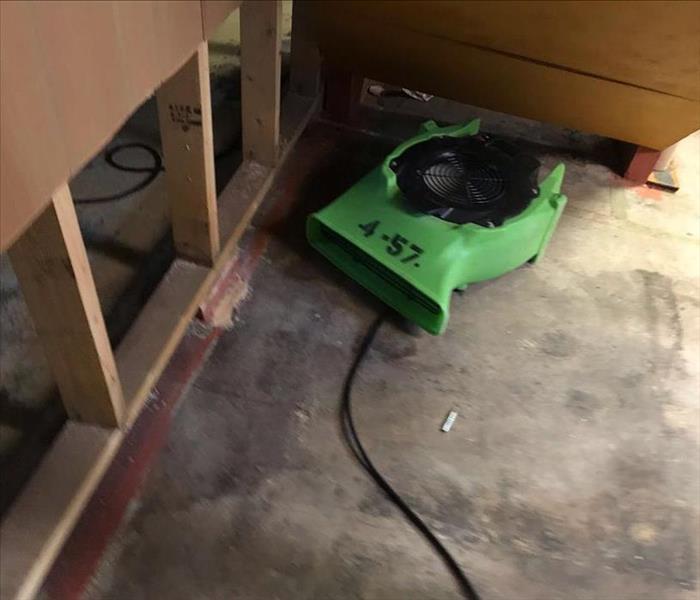 The professionals at SERVPRO properly place drying equipment to avoid secondary water damage!
The professionals at SERVPRO properly place drying equipment to avoid secondary water damage!
Secondary water damages can be avoided when the right team of professionals arrives!
Water damages are single-handedly any homeowner's worst nightmare. The only thing that can make matters worse is secondary water damage. Not only is it a nuisance to deal with it, but if left unchecked, it can cause some serious damage to your home or business.
But no need to worry; with this quick guide on secondary water damage, you'll know how to handle the situation in no time!
What is Secondary Water Damage?
Secondary water damage is damage that occurs when primary water damage is left unattended to or is not properly resolved. Secondary water damage causes the water to seep deeper into your house's structure, and the more thorough the water infiltration, the worse the damages will be.
Typically, with secondary water damage, the level of damage is unknown until professionally inspected. You need to have your property professionally inspected because the source and the exact cause of the damage may not be easy to discover, making it difficult to mitigate the water damage issue properly.
Noticing Secondary Water Damage
Believe it or not, secondary water damage is not that easy to spot, at least not right away. Secondary water damage usually works its way from the inside out; weeks or even months can pass before it begins to show any exterior signs. By this stage, substantial damage has already been done, and a reversal will require professional help.
The most common markers of secondary water damage are:
- Rotted drywall
- Buckling floors
- Warped floors
- Peeled vinyl
- Black spots on the wall
4 Types of Secondary Water Damage
Secondary water damage takes form in several different types; it is best to be aware of them all so that you can quickly catch the tell-tale signs.
Type 1: Mold
Mold will typically appear within 24-48 hours of moisture entering a surface or material. Mold spores will keep growing the longer it is left unattended.
Type 2: Corrosion
Corrosion occurs when structures made out of metal, such as pipes and rods, are subject to water damage. Metal materials left to rust can weaken metal structures and possibly cause more water damage when a pipe bursts.
Type 3: Electrical Damage
If water damage spreads to electrical outlets, it can cause electrical damage. Not only can this cause appliance damage and electricity cuts, but it can also prove dangerous through electrical shocks.
Type 4: Rotting Wood
Issues of rotting wood are once again caused by persistent exposure to water, and if these are not tended to then, this could affect the integrity of your house's structure.
What causes secondary water damage?
While it's evident that secondary water damage is caused by persistent and continued exposure to water, it is more specifically the result of a lack of action than anything else. Water damage will progress to secondary water damage if a prompt response is not given when a water disaster strikes! Secondary water damage makes treatment both more time-consuming and difficult.
The best course of action is to call a professional water restorer as soon as you notice any signs of ceiling water damage or water seeping through the floor. While you wait, try to investigate the source and see if a temporary fix can be found to prevent further secondary damages. Remember, the only real way to prevent secondary water damage is to ensure that the water is completely extracted and dried in the first place.
So, there you have it, a quick and easy guide to all the basics of secondary water damage. Know you know what to look out for when your property undergoes water damage.
Contact us as soon as possible if your property has recently had water damage. When we receive your call, we will act quickly to avoid secondary water damage at your property!
4 Steps to Mitigate Water Seeping Through The Floor
2/1/2021 (Permalink)
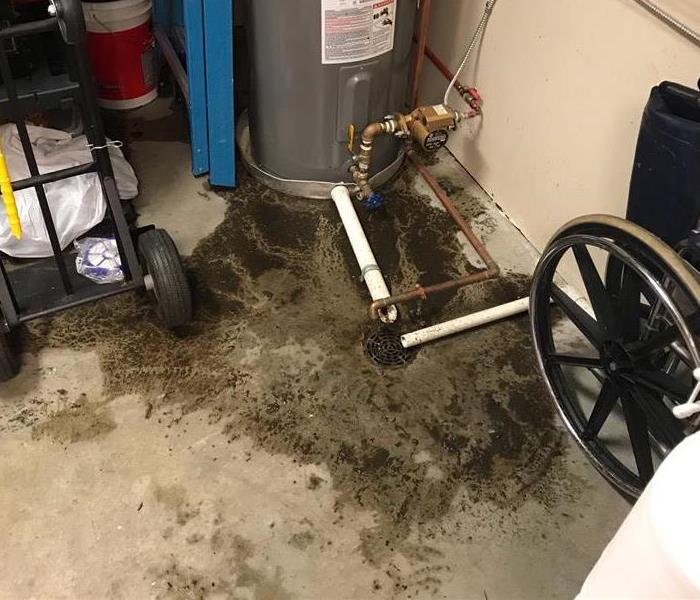 Contact the water damage professionals for all emergency services!
Contact the water damage professionals for all emergency services!
Understand why standing water is dangerous inside your home
It is always devastating when you realize that your home has suffered from water damage. Not only is it emotionally draining, but if left untreated, it can cause structural issues to your home and result in expensive repairs. It is essential to avoid secondary water damages, so call experts at SERVPRO of South Cobb to amend the problem before it is too late. Whether that water damage results from water seeping through the floor or a ceiling that has collapsed, our IICRC certified experts got you covered!
How can water damage occur in your home?
There are plenty of ways water can enter your home and start damaging your property. Here are some of the most common ways water enters your home!
- The most common way that water can enter a property is through concrete flooring cracks. Excess amounts of water under your basement floor can create immense pressure. Extra pressure will lead to water entering your property through the cracks inside your home.
- Some standard construction methods leave space between the poured basement floor and the footer. Similar to the first way, water may find its way through these small spaces to the insides of your home.
- The hydrostatic pressure created by excess moisture in the soil can create cracks in the foundation walls and allow water to seep inside your home.
- Additionally, leaking pipes can also cause water to come inside your home through walls and floor and may stand for days or even months if unnoticed.
- Apart from leaking pipes, several drainage issues can cause water to seep up through the floor until they are repaired.
Why is standing water inside your home dangerous?
Now that you know how water can seep inside your home through the floor and/or walls, let's go over the dangers of leaving untreated water damages.
- It can cause the loss of precious living space inside your home.
- It can cause structural damage to the property.
- Compression, bowing, and cracking of basement walls.
- It can devalue your home by mold growth.
- The living standard can deteriorate due to poor indoor air quality.
- It can cause several electrical issues.
Four steps on how SERVPRO mitigates water damages
Once you discover signs of water seeping through the floor or other signs of water damage, it is highly recommended that you give experts at SERVPRO a call to help fix the problem. Once you contact us, we will use the following 4 steps to ensure the water damage issues are resolved.
Step 1: Find the origin of the leak
Before we start repairing anything, we need to examine the cause of the leak and why the water is seeping into your home. We will carefully examine your house and look for signs for any possible water damage to see why the water is seeping inside your home. We use top-of-the-line equipment, and our professionals have several years of experience in water damage repair!
Step 2: Stopping the leak
After a thorough investigation and examination, once we find the origin of the leak, we design a plan to stop the leak. For leaks that are caused by plumbing malfunctions, we will shut off all the water supply in your home and drain the excess water. Once all the water has been drained from the plumbing system, we will continue by fixing the leak, so water does not damage the walls or floor again.
Step 3: Drying your home
Once the leak has been fixed, we start drying out your home and remove all standing water. Our goal is for you to quickly start living your everyday life back before the damages occurred. We will give you and your home insurance company a dry report to ensure that your property has completely dried out.
Step 4: Preventing future damages
Once our work is complete, we will advise you on preventing future water damage from happening again. There are many precautionary measures you can take to avoid future water damages. Every home is different and has different areas for potential water damages, and we want to ensure you are well prepared!
Concluding thoughts
SERVPRO of South Cobb can restore all water damage to flooring and help you get back to your normal routine as soon as possible. Contact us at the first sign of water seeping through walls or flooring so our certified experts can mitigate the issue as quickly as possible!
4 Steps To Repair A Water Damaged Ceiling
1/18/2021 (Permalink)
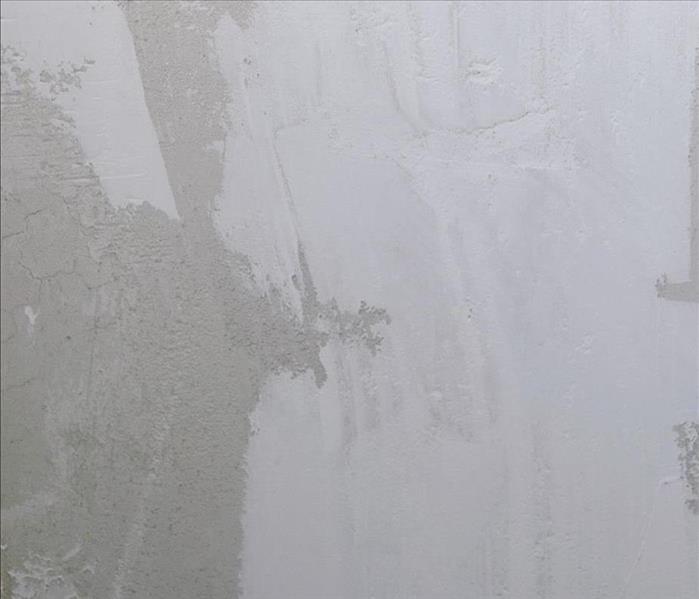 Water damages can cause the ceiling of your home to collapse!
Water damages can cause the ceiling of your home to collapse!
Learn how the professionals repair a water damaged ceiling
Water can be disastrous when it comes in contact with the drywall that makes up your ceilings and interior walls. Enough water damage can cause a ceiling to fall apart or collapse. However, there is no need to stress once you call water damage professionals. SERVPRO of South Cobb can repair ceilings and walls that have been affected by water damage. They have the required tools and experience for any size water damage repair. Learn how the professionals suggest you handle water damage to the ceiling of your home in 4 simple steps!
Step 1: Inspect your home for damages
It’s crucial to conduct regular inspections to detect any signs of water or mold damage in your household. If there is peeling or blistered paint on your home ceiling, it may be a clear indication of water damage. When water damage signs are visibly seen, there is a chance that there are hidden water damages that can lead to structural mold growth. However, identifying the root quickly and trusting a local restoration company can immediately prevent the issue from becoming more significant.
Step 2: Detect the source of the water
It’s quite challenging to identify the water leakage source when the water has traveled to an unexpected area. However, depending on your home's layout, ceiling water damage can start from either plumbing malfunctions or roof damage. If the water damage is directly below the roof, it could be due to an ice dam or issues with a chimney. Clogged gutters can also result in water damage.
Clear indications of ceiling water damage:
- The ceiling drywall is wet
- Dark water spots on the ceiling
When you notice water damage, it is essential to contact a property restoration professional who can assist you in this situation and detect the water damage and find a solution; otherwise, it could lead to more severe repairs. During the initial inspection, it is essential to ensure no mold has grown.
Step 3: Dry and remove the damaged ceiling
The wet area needs to be dried properly to prevent unhealthy mold growth. Water damage professionals will strategically place drying equipment to ensure the ceiling is dried properly. Once the water damage is mitigated, it’s important to replace and remove the ceiling materials that are severely damaged. Depending on the category of water damage, personal protective equipment will be worn before starting. If water damage has occurred in the attic, you need to make sure to replace and remove any wet or damp insulation.
Step 4: Repair the damaged ceiling
Once the water mitigation is complete, the home can be put back together. Exact drywall measurement cuts will be taken to ensure a proper drywall fit on the home of your ceiling.
Call the professionals at SERVPRO
There are numerous advantages to hiring professional water restorers. Firstly the water damage company has the proper equipment and certified experts to perform the water damage job. A water damage company will make sure that your home is in good hands and everything is conducted professionally. If you think that water damages are a task that can be done on your own, you’re wrong; it can result in more damages.
SERVPRO is the property restoration company that businesses, schools, and families trust. Trust us when you have water damage or need further guidance. Our team consists of IICRC certified experts and professionals that are here to assist you 24 hours a day! We are just one call away!
Stopping Water From Running Down Outdoor Steps And Into The Basement
11/23/2020 (Permalink)
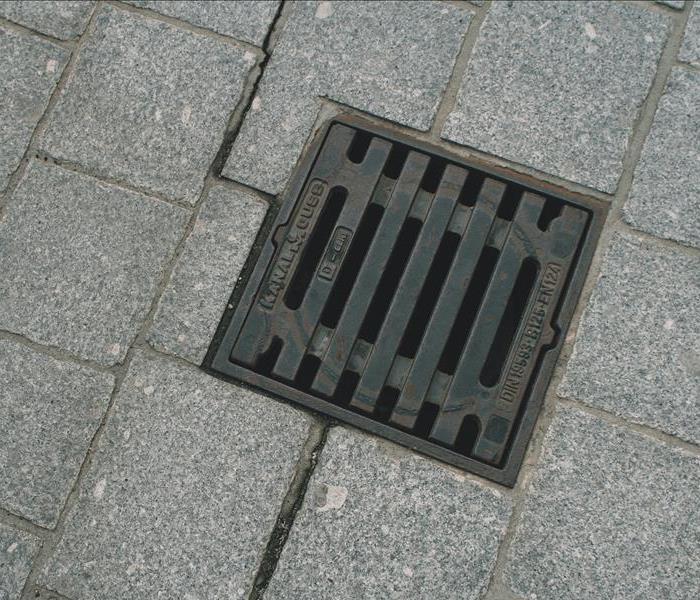 Check your outdoor floor drain regularly to prevent basement flooding!
Check your outdoor floor drain regularly to prevent basement flooding!
A Blocked Drain Can Lead to Water Intrusion
An outdoor drain plays a different role from the ones inside your home. An outdoor drainage system will prevent water from running inside your home and causing water damage. A properly functioning outdoor drain is the reason why your home does not flood every time it rains.
However, if the drain is blocked, it can cause severe water damage to your property. You must take the proper steps to prevent water from running down the stairwell and into your basement. This post will go over all actionable items to take when you notice standing water in the stairwell.
4 Steps To Prevent Outdoor Water Intrusions
There are 4 steps you can take to prevent water from running down the stairwell into your basement. These actionable steps can help prevent future water damages and allow you to have some added protection to ensure low insurance premiums!
1) Make Sure That The Drain Remains Unclogged
The most common reason for standing water in the stairwell is a clogged drain. A drain can easily be covered with mud, leaves, grass, or even garbage. The SERVPRO professionals recommended regularly checking your outdoor drainage systems and for standing water in the stairwell.
2) Install A Stairway Cover
We know that this option may not be possible for all home designs, but you can install a stairway cover to protect the stairwell from the outdoor elements if possible. Typically we have seen homeowners install a metal hatchway or similar type of cover. Installing a stairway cover will help reduce rainwater from reaching your basement and stairwell drain cloggings.
3) Inspect The Surroundings
In many cases, when inspecting a basement flood, we have determined that the reason is a flawed drainage system. For starters, a poor landscape drainage system will leave the stairwell drain to have to work harder because it will have to take on draining the rainwater and the water coming from the landscape runoff. Also, please pay attention to the gutter system and ensure that they are in proper working function. Water coming from roofs and downspouts can cause drainage issues and leave standing water in the stairwell.
4) Reinforce The Basement Door
Lastly, you can reinforce the basement door to ensure that none of the water from the stairwell gets inside your basement. Even if there is standing water in the stairwell, it will still not be able to come inside the basement, protecting you from basement flooding.
How To Unclog An Outside Drain
If you find standing water in the stairwell is due to a clogged drain, you first need to assess the problem to make sure that it is not a simple fix like leaves covering the drainage system. If the problem seems to be more severe, it is best to call a professional plumber to come out and help.
Basement Water Damage Professionals
If the problem persists and you notice water damage inside your home due to a defective drainage system, you need to contact IICRC certified professionals. SERVPRO of South Cobb are experts in water damage restoration and have partnered with the top Atlanta plumbers to ensure that there will no longer be standing water in the stairwell from a clogged drain. The sooner you call experts at SERVPRO, the greater the chances of preventing future water damages.
Call us at: (770) 739-2355
1 Important Reason To Remove Drywall After Water Damage
9/14/2020 (Permalink)
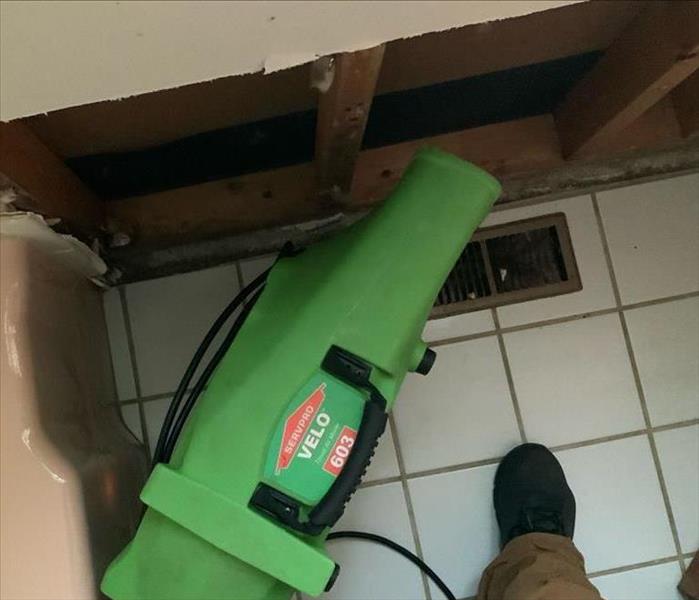 The team at SERVPRO is ready to dry any structure after water damage.
The team at SERVPRO is ready to dry any structure after water damage.
Drywall is relatively cheap regarding other interior construction materials. Drywall is composed of gypsum (calcium sulfate dihydrate), paper, and other compounds such as mica, clay, and resin. Because of the makeup of drywall, water exposure will quickly cause damage.
Being a well-known company in the restoration industry, we understand that water exposure to water is not a strong point for drywall. To save drywall after water damage, a few factors need to be taken into consideration.
How does SERVPRO save drywall after water damage occurs?
In the case that the drywall only has a brief exposure to water for a short amount of time will make saving drywall much more manageable. The team at SERVPRO has saved drywall from splashes from an overflowing appliance. We know it is essential to act fast so that water is not absorbed into the drywall.
Small water damages are relatively easy to mitigate. If you have experienced as small water damage start by wiping down the wet areas immediately with towels and then point a fan at the affected drywall. We advise running a fan for a couple of days on the affected drywall to ensure that it is dry. If you want to ensure that the area is dry, you can invest in a penetrating moisture meter. All you have to do is stick the two pins into the drywall and see that moisture levels are equal to the dryness of drywall on a non-affected area.
When to remove wet drywall after water damage?
When drywall is heavily soaked from either flooding or another severe incident, the gypsum in drywall will become visually saturated. You will notice that the drywall is ultimately damaged when the drywall looks deformed and saggy. In more severe cases where the affected drywall has sat for a while, you will notice that it has completely collapsed inward.
Drywall is difficult to save after severe damage. When our technicians perform the most extensive drying techniques offered by the IICRC, the drywall will still not return to its original shape. We have found that it is best to remove and replace the drywall altogether to avoid a mess of crumbly drywall material.
The Number 1 Reason To Remove Drywall After Water Damage Occurs
The main reason that we find it essential to remove drywall after water damage is to avoid mold contamination. At first, the wet drywall in your home or business may seem intact and fine, but it is best to call a water damage restoration company. Delaying the drying process will enhance the possibility of mold growth on the drywall.
Drywall Mold
Mold on drywall will typically show up as dark spotting or blotches on the wall's exterior. Mold growth can occur within 24 to 48 hours after the drywall has been affected by water damage. The trained technicians use an antimicrobial during any water damage and mold jobs to stop further mold growth. An antimicrobial like Benefect will prevent the mold from growing further but remember that once mold has penetrated below the surface into the porous gypsum material, it is better to remove and replace it by a certified mold remediation company.
Although water damage can cause severe mold issues, we do have good news. Drywall is easy to remove and can be replaced with a few hours after the home structure has been dry. Call the professionals at SERVPRO of South Cobb if your home or business has recently suffered from water damage. We are the go-to water damage company in Smyrna, Georgia.
More about Smyrna.
Call us at (770) 739-2355.
Who To Call for Flooding?
8/17/2020 (Permalink)
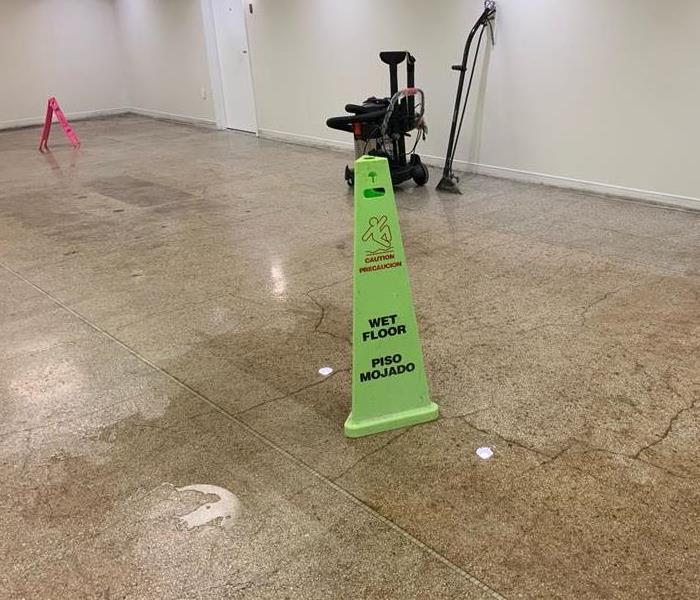 We are available 24/7 to service all water damage restoration emergencies
We are available 24/7 to service all water damage restoration emergencies
SERVPRO is available for all types of flood damages and has an on-call crew for Late Night Water Damage Mitigation
SERVPRO techs provide Atlanteans with water damage repair
Commercial and residential owners are susceptible to be affected by water damage. Water damage can result from a burst pipe in a restroom or a sink overflow in the kitchen. SERVPRO is one call away for fast cleanup performed to code, to ensure employees and customers are safe.
Are you in need of comprehensive water damage repair services in Atlanta?
WHAT CAUSES BASEMENT FLOODING?
We have received the following calls as the result of basement flooding:
- Oversaturation of groundwater
- Broken sump pumps
- Storm drain backup
- Burst pipes
- Leaking appliances/fixtures
SERVPRO services cover everything from water extraction to structural and contents drying.
What NOT to do during a flooded basement?
- Do not flush an overflowing toilet. A toilet overflow indicates a possible plumbing issue, and flushing makes the problem worse.
- Do not handle dirty water on your own. Toilet water has microbes that are not safe to handle without proper personal protection equipment (PPE).
- Do not DIY plumbing repairs. It is best to have a certified plumbing professional service a broken pipe or clogged pipe.
What TO DO during a flooded basement?
A flooded basement is one of the most frustrating things a property owner will endure. Following these three steps will help you navigate the situation:
STEP 1: CALL YOUR INSURANCE COMPANY.
Property insurance and renters insurance often requires special flood insurance for flooding caused by mother nature. Flood coverage is typically not covered by your regular policy. However, most insurance policies cover flood damage caused by appliance failure or a burst pipe.
You can count on SERVPRO to work directly with your insurance company throughout the water cleanup, extraction, and water removal process so that your claim goes as smoothly as possible.
STEP 2: REMOVE IMPORTANT ITEMS.
Once it is safe to venture into the flooded basement, it is good to get all of your essential and sentimental items to a dry area. We recommend only removing objects that have been affected by clean water and not by any dirty water because contaminated water can carry pathogens that can be harmful to touch.
STEP 3: CALL YOUR LOCAL SERVPRO TO CLEAN UP, SANITIZE, AND DEODORIZE.
Once water cleanup begins, remember to keep safety first. Do not use electronic devices that have come into contact with the water. When you call SERVPRO, you will be hiring trained professionals that specialize in water cleanup. All of our SERVPRO specialists have received the Institute of Inspection, Cleaning, and Restoration Certification (IICRC). The IICRC certification guarantees compliance with standards for professional water damage and flood damage restoration.
Every single one of our SERVPRO trucks is equipped with water extraction, drying, and moisture testing equipment to handle any size damage.
SERVPRO is here to help!
SERVPRO technicians use precise calculations to determine both the placement and proportion of their water damage equipment. There are many variables involved when handling water damage. We have seen every size disaster and are ready to handle anything that comes our way. Call SERVPRO of South Cobb today at (770) 739-2355, and one of our technicians will arrive within four hours.
Broken Pipe Under Kitchen Sink Causing Water Damage
7/13/2020 (Permalink)
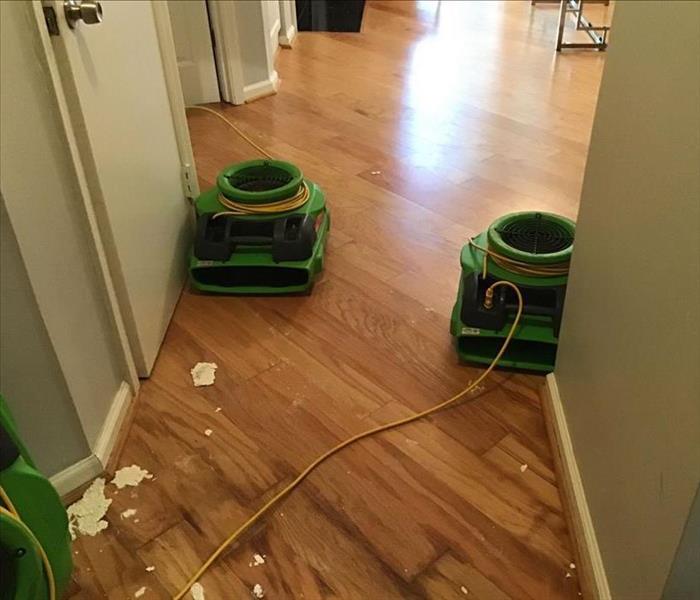 We have the equipment to save your home from further damages!
We have the equipment to save your home from further damages!
Water damage from a broken pipe under your kitchen sink can cause more severe damage if not cleaned up quickly and adequately.
At the first sign of water damage, it is vital to act quickly before more damage occurs. In the case of a broken pipe, you must stop the water source from leaking, typically stopping the use of the kitchen sink altogether.
Once stopped, call your local water damage professionals at SERVPRO of South Cobb. We will come out to your house, assess the damage, clean and dry the affected areas, and restore it “Like it never even happened.”
The professionals at SERVPRO have seen it all. Once on-site, we can identify the source of the water damage, classify the type of water, and put together a plan of action to properly mitigate and restore the affected area.
Restoration professionals have the equipment necessary to find areas that are not obviously affected. They will then make the drying and restoration process possible to occur.
In the case of water damage caused by a sink pipe, the water damage you will experience is clean water.,Clean water is essential to address it quickly before further damage occurs. Our SERVPRO is equipped to handle all situations, whether large or small.
If the water damage is left to sit for a few days, you can guarantee that any wet materials will experience mold damage. Permanent mold damage happens quickly. The cabinetry wood surfaces will start deteriorating, and mold will begin to appear because of the moist conditions. Act quickly when you find standing water to avoid the headache from mold damages.
What to do while you wait for SERVPRO to arrive?
- Stop the water source that is causing the water damage.
- Remove as much excess water as possible by mopping and blotting.
- Remove all materials that are valuable or sensitive to moisture.
- ALERT! If mold is visible, do not move anything because mold spores can quickly spread and damage other parts of the kitchen.
To prevent future water damage, it’s a good idea to make sure that you are continually checking your home appliances for leaks. If you spot a leak to any of your home faucets, it is good to get them fixed ASAP to prevent water damage from occurring in the future.
Just as you have your favorite electrician or plumber, it is also essential to have the number of a 24-hour emergency water damage restoration company, like SERVPRO of South Cobb.
Lastly, we suggest that you double-check with your insurance provider on the type of coverage that you obtain. When water damage occurs, we want our residents to have quality insurance coverage for your home and your possessions so that the restoration services and items that may need replacing are going to be covered.
In case of emergency, rely on the professionals at SERVPRO of South Cobb to clean up the damage. We are available 24/7 to clean up any water and mold damages that your home has recently had.
If you have any questions, please call (770) 739-2355.
SERVPRO 6 warning signs to avoid water damage from drains
5/25/2020 (Permalink)
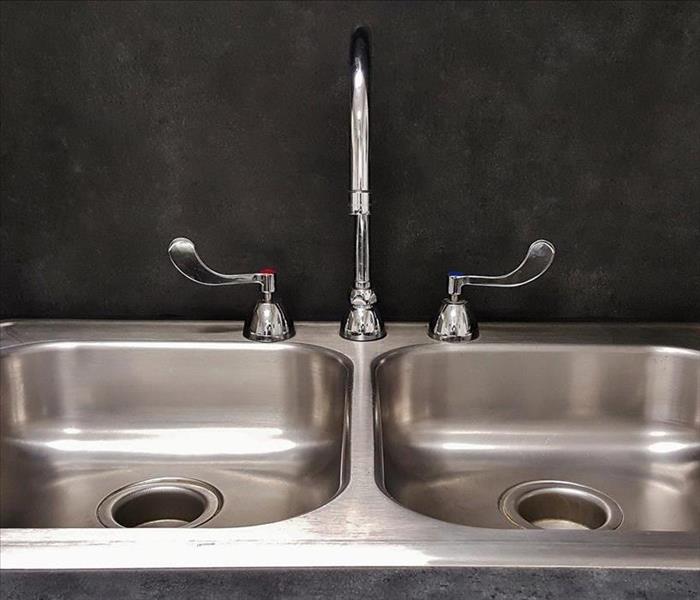 Our IICRC trained professionals are here to help you, 24/7.
Our IICRC trained professionals are here to help you, 24/7.
Most of the calls that we receive at SERVPRO of South Cobb are from common plumbing problems caused by various reasons. The biggest water damage jobs cause a lot of grief for the homeowners. The problem is that most of these water damages can be completely avoidable if an Atlanta resident knows the signs of plumbing build up.
Proper use of drains
We want our Atlanta residents to remember that drains are meant to remove wastewater. One hundred percent avoidable water damages happen when homeowners or residents try to put trash, hair, leftovers, and the other materials down the drain. Flushing non-wastewater down any drain will most likely result in a water damage insurance claim.
Build up in Atlanta plumbing
There are a good bit of structures in the Atlanta metropolitan area that was built before the 1970s. Because of the age of the Atlanta structures, it is possible that grimy buildup made of soap scum and bacteria has collected in your plumbing. Once buildup starts collecting, other debris like trash, and hair collect as well.
Six Signs That Build-Up Has Occurred:
Toilet Overflowing while Shower is running
An overflowing toilet during a shower is a clear indication of a blocked drain line. If the toilet continues to overflow, it is necessary to call a local Atlanta plumber for a proper sewage cleaning. If the water has overflowed to a point where a homeowner is concerned, they should contact SERVPRO of South Cobb. We offer water damage cleanup services. We will come into your home and remove standing water, apply antimicrobials to the area, and suggest recommendations on which contents should be disposed of or restored.
Toilet Not Flushing
Have you ever spent your morning trying to unclog a toilet? If not, you are a lucky individual. A toilet, not flushing, is the most common warning sign that a drain is clogged. In uncomplicated cases, a clogged toilet is the result of too much toilet paper being flushed. In more severe cases, we have seen kids trying to flush a toy down the toilet. A backed-up toilet may cause a lot of damage to the bathroom and surrounding rooms.
Slow Drainage While Running Water
The buildup of soap scum and hair are often the reason for a drainage issue to occur. Slow drainage can affect a sink, tub, or shower. To avoid water damage from slow drainage, we recommend that you stay on top of regular drain cleaning. There are many liquid drain cleaners that you can purchase at your local grocery store. Please read the instructions carefully when using drain cleaners to avoid any harm.
Drain Stench
Another sign of a clog is from any drain that smells bad. Several factors can cause a drain smell if the smell does not go away after using drain cleaner we recommend hiring an Atlanta plumber to come out and check on smell.
Gurgling Noise From Drain
A gurgling noise that occurs in a drain is another indicator that a homeowner has a clogged drain. The gurgling sound usually comes from air that is trapped in your pipes. This noise is an indicator that a clog has occurred further down your home sewer line.
Yard Puddles
Unexplained puddles of water in your yard are a sign of a clog. Pools of water need to be taken care of quickly because the water may enter your home and cause further damages. In either case, you can call SERVPRO to help evaluate the best solution to avoid home water damage.
We want our Atlanta homeowners and residents to know how to turn off the water to their homes. The main water shut off is located in different places in each home or building. If you want help finding your emergency water shut off valve give SERVPRO a call at (770) 739-2355. Our IICRC trained professionals are here to help you, 24/7.
SERVPRO Is Here To Help Spot Water Damage Pt 1
4/13/2020 (Permalink)
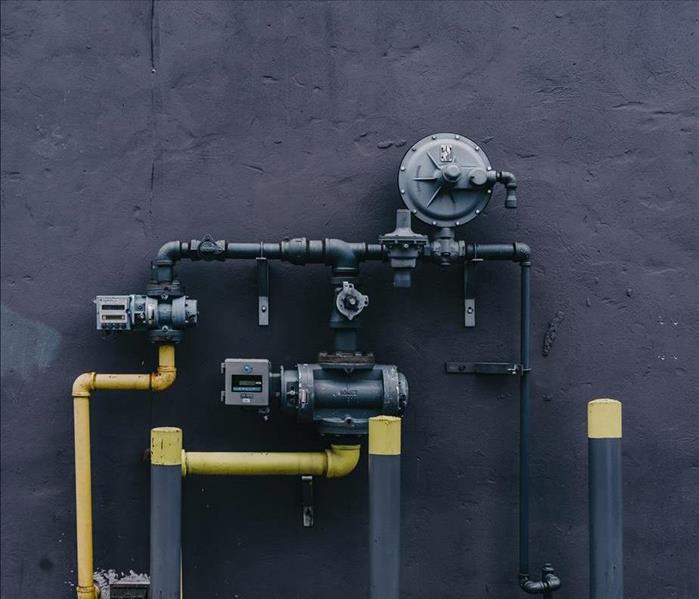 Our professionals are trained to quickly locate the main water shut off is in your home or business.
Our professionals are trained to quickly locate the main water shut off is in your home or business.
There are many signs that your home or business has been damaged by water that can range from a burst pipe spraying into a hallway to something as subtle as a small dripping leak that goes unnoticed for months. No matter the source, water damage is crucial to respond quickly to restore anything damaged and prevent any further damage from being done. The problem sometimes with spotting water damage is that it isn’t always apparent, so you may not even realize you have a problem until it’s a big one. A professional water damage restoration company like us here at SERVPRO of South Cobb can detect most issues with specialized equipment and trained professional technicians, but how would you know that you need to call us in the first place? Please give us a call if you feel that your home or business may be suffering from water damage. We have the advanced equipment and expertise to turn the loss around and make it, “Like it never even happened.”
The Best Way to Protect Your Home from Water Damage
4/6/2020 (Permalink)
Dealing with water damage in your home or business can be overwhelming and costly. The average bill to repair and restore water damage to a home or business is thousands of dollars, and damage can be anywhere from the basement to the roof. You should be especially aware if you live in a flood zone; however, water damage can still occur at any time and anywhere around your property. At SERVPRO of South Cobb, we pride ourselves on our industry expertise with handling water damage and restoring your home or business to its original state. Here’s how you can best protect your home from water damage to be prepared year-round.
It’s first best to know the most common causes of water damage to know what to look for and where to look if your home or business suffers water damage. Here’s a list of some common cause of significant water damage:
- Roof damage (broken/missing shingles, cracked flashing, etc.)
- Burst or leaking pipes
- Leaking household appliances such as laundry machines or dishwashers
- Extreme weather and floods
Some things to look for when trying to determine if there is water damage in your home or business are:
- Warped or sagging ceilings
- Peelings paint/wallpaper
- A musty smell of mold and moisture
- Warped floors
- Water pooling in areas of your lawn
The big secret to best protecting your property from water damage and other damages is in home maintenance. Inspect your roof. It takes the forefront of the elements 24/7 year-round. Your roof should be inspected periodically to ensure all shingles, caulk, and flashing are in place and undamaged. Your gutters should also be maintained to ensure that proper drainage is available to water running off your roof. If your gutters are clogged, and water cannot correctly escape your roof, it can pool on the roof or around your foundation, leading to potentially severe water damage. Your windows can be caulked to prevent snow and other moisture from penetrating inside during inclement weather. This also applies to indoor areas that may be exposed to water as the kitchen and bathroom by caulking things like sinks, tubs, and backsplashes so that water cannot get into the walls of your property. The best sealant to use for these indoor areas is one that is 100% silicon. Silicon caulking is waterproof, doesn’t crack over time, and is flexible, unlike acrylic caulk, which can shrink over time, allowing water through.
While all these steps may be taken to prevent water damage from occurring, it cannot be guaranteed that water damage can be prevented. Things like natural disasters and floods arise, and water damage can still happen. However, no matter what event may occur, you can call our trained water damage restoration professionals here at SERVPRO of South Cobb, and we will make it our top priority to get your home or business back to its original state so that you can take a breath. No one wants to deal with water damage to their property, SERVPRO will be there for you.
SERVPRO of South Cobb at (770) 739-2355 is ready to help local homeowners with flood damage. They have the advanced equipment and IICRC expertise to turn the loss around and make it, “Like it never even happened.”
What to Expect From the Water Restoration Process
3/23/2020 (Permalink)
Since every flood and water damage scenario is a little different, each one requires a unique solution tailored to the specific conditions. However, the overall water restoration process remains the same. The process begins when you give us a call. SERVPRO of South Cobb is available 24 hours a day for any size water emergency.
Immediate action is crucial when facing flooding or water damage, and a delay of just a few hours can drastically increase the severity of water damage left behind. While water damage can be chaotic and traumatic to deal with, SERVPRO of South Cobb has the expertise and experience to help you through a water damage disaster.
When you give us a call, we will ask you questions to assess the situation and determine what equipment and resources will be necessary to bring. Upon arrival at the site of water damage, we begin with a detailed inspection and damage assessment of your home or property to determine the scope of the water damage to create the best plan of action. After inspection, we will identify the source of moisture in your home or business and the type of water. When dealing with water damage, there are three types of water according to their level of contamination: “Clean Water,” “Gray Water,” and “Black Water” is used to classify how contaminated the water is so that our trained SERVPRO Professionals can restore your property to industry guidelines.
The next step of the water damage restoration process is the actual water removal. After the damage assessment and the source of moisture have been stopped, the water extraction process may begin. If the water damage is great enough to call for extensive restoration or cleaning, SERVPRO of South Cobb can assist with an organized and efficient move-out to ensure your belongings are protected from any further damage. Our highly trained technicians will then begin the water removal process immediately once the surrounding area is cleared. Depending on the level of damage, our technicians may use equipment varying from industrial wet/dry vacuums to powerful submersible pumps.
Once all water has been successfully removed, the drying and dehumidification process is next. While floors and walls may appear to be dry, they will be wet to the touch as most building materials such as wood and drywall retain water once submerged. Our Professionals use measurements, temperature, and humidity to determine best how much equipment such as dehumidifiers and air movers will be needed to dry your home or business.
Most of your home or business will require professional cleaning following water damage from the floor to the ceiling. After monitoring the drying process, our technicians will clean your property’s structure, furniture, upholstery, clothing, and any other restorable items or property damaged by water. Following any kind of damage, your home or business will require cleaning, odor removal, and sanitization depending on the scenario. Our technicians here at SERVPRO South Cobb are trained to deodorize, sanitize, and dispose of damaged materials in your home or property.
The final step following a water damage disaster is the restoration of your home or business to its pre-water damage condition. This may involve minor repairs such as replacing drywall to major repairs such as the reconstruction of various rooms or areas. Our professionals will provide immediate protective measures during the water damage restoration process, such as tarps, and will handle rebuilding all affected areas. We are a company qualified to handle the initial damage and rebuilding of the area afterward, and can guarantee to get any building back up to full functionality.
SERVPRO of South Cobb is ready to help local homeowners with flood damage. They have the advanced equipment and expertise to turn the loss around and make it, “Like it never even happened.”
Does Your Insurance Cover South Cobb Water Damage?
2/17/2020 (Permalink)
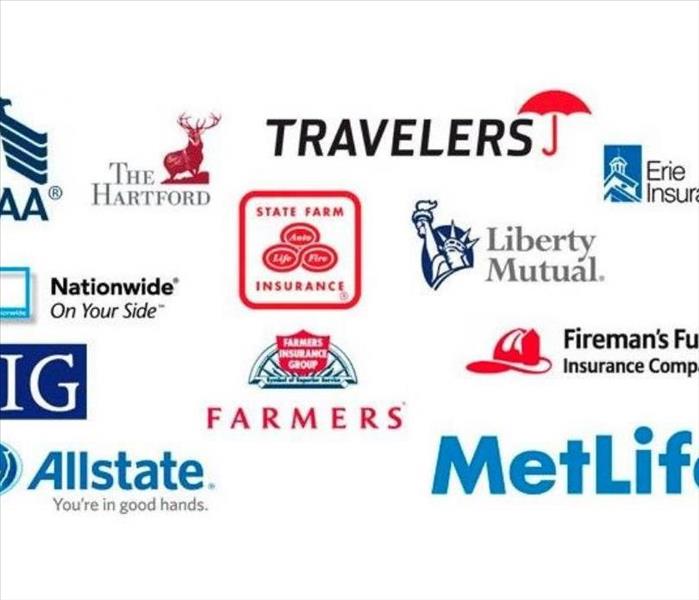 Home water damage insurance
Home water damage insurance
Approximately 98% of basements will experience water damage in their lifetime. The inevitability isn’t too surprising considering basements are underground and therefore prone to things like gravity and the consequences of whatever happens in the home above. Considering this statistic, it’s safe to say that understanding the processes of both the water damage itself and the restoration required to fix it is genuinely useful for homeowners.
Here’s what is important to know about water damage.
First off, water damage insurance and flood insurance are different. If you live in an area not prone to floods, you don’t need to get flood insurance just to protect your home from water damage. They’re different insurance types entirely. In addition, not all water damage is actually insured. For instance, water damage related to neglect of the property may not be covered the way a sudden disaster’s effects would be. Once water damage has impacted the home, in any area, call insurance immediately. The sooner the better since they need the complete details in order to determine the cause, the damage, and therefore pay the restoration company. If you find dealing with insurance a pain, no worries. SERVPRO of South cobb can help you with insurance in addition to repairing the site of the water damage.
Once insurance is dealt with, there are a few other things to consider. Some water damage, depending on the source, can be polluted and dangerous to be in or around. It is not recommended to explore the damage personally, especially if it’s a large quantity of water and in a location like a basement. In addition, the moment the water damage happens it is getting worse and worse every minute. That is why there is a sense of urgency that comes with water damage. More than the water, the dangers of water damage come with water the water causes. This includes mold growth, structural damage, destruction of personal items. The sooner the area of damage can be dried and restored, the better off the home is. The same way you wouldn’t avoid going to the doctor if a sudden pain erupted in your body, your home needs similar urgency to keep its integrity and continue to serve you and your family in a safe way.
In case of a water damage emergency, consider SERVPRO of South Cobb. They can assist you with your insurance, be at the site within twenty-four hours, and use the most powerful possible equipment to return your home to normal in no time.
Causes of Commercial Water Damage to Watch Out For
1/6/2020 (Permalink)
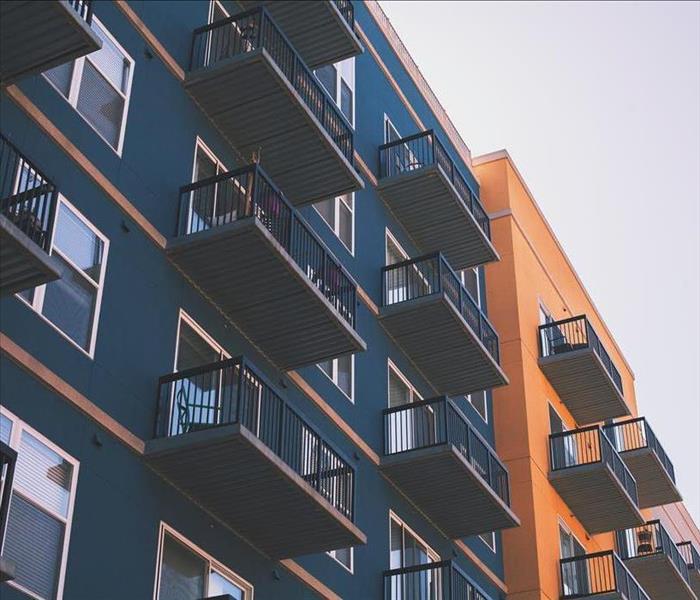 Water damage can happen anywhere.
Water damage can happen anywhere.
There are a lot of things to consider when maintaining a commercial property. Of course, safety is managed by laws and requirements that every commercial property must maintain, however unexpected damage is still possible. One case of unexpected commercial property damage is water damage. Commercial water damage can not only be a safety threat, but be incredibly costly to repair. So here are some possible causes of commercial water damage to watch out for.
Windows with cracks or weak construction can allow leaks from weather to invade the interior of the building. Make sure windows are strong and up to date. The foundation of the building is an easy place for water damage to occur since it’s low to the ground where water runoff or storm build up can accumulate. Ensure regular check ups of the integrity of the foundation, including cracks and leaky pipes. Sprinkler systems are required in buildings for safety reasons, but nonfunctional sprinkler systems can pose a threat by unexpectedly turning on and soaking rooms. Like the other causes, make sure someone is constantly assuring the quality of the sprinkler system. The answer to all of these possible causes is to invest in a person or team who can ensure the maintenance of the commercial property.
If you own or maintain a commercial property that has experienced water damage, no matter how much, call your local SERVPRO of South Cobb at (770) 739-2355. SERVPRO of South Cobb has dealt with commercial water damage before and knows exactly how to fix and restore your commercial property to make it “Like it never even happened.”
Atlanta Homes with Window AC Units Could Be Welcoming Water Damage
3/23/2018 (Permalink)
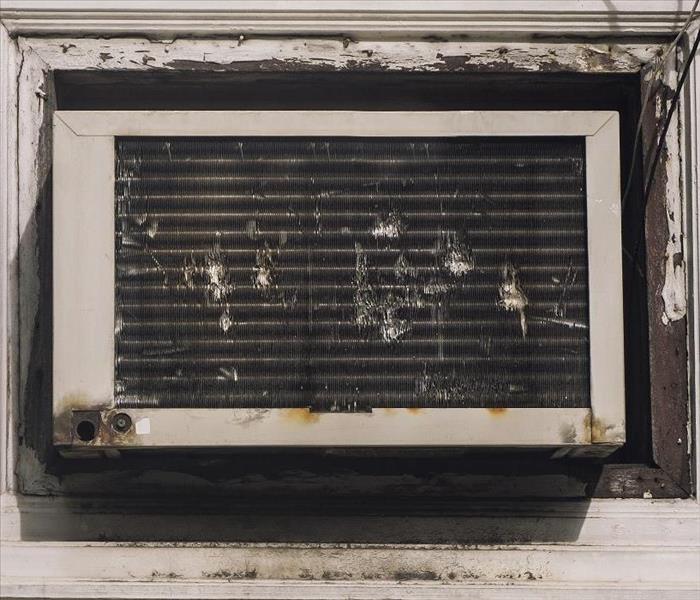 Window AC units are not made to last forever, if your unit fails and causes water damage in your home call SERVPRO to help.
Window AC units are not made to last forever, if your unit fails and causes water damage in your home call SERVPRO to help.
SERVPRO Can Help Restore Your Home after Water Damage
When you think about your Atlanta home, there are likely many convenience appliances that come to mind to help you live more comfortably. While these might seem like typical staples of the modern home, without the proper preventative maintenance and occasional forward-thinking repair work, some of these appliances can make your life anything but convenient. Take for example the air conditioning units hanging in the windows in various areas of your home.
With the water that has to pass through the system from both condensation and the natural production of cooled air, a malfunction to your air conditioning unit could result in substantial water damage to your Atlanta home. If one of these units were to malfunction, it stands to reason that removing it from the area might prove to be a difficult task. Fortunately, there is often only a finite amount of water in one of the units at any given time, meaning that at worst, the water eventually does stop pouring out of the appliance.
The best thing that you can do for the sake of your home and the structural integrity of areas like your floor supports might be to contact our experienced SERVPRO professionals. When our team arrives at your home, the quick initial assessment determines the full scope of the possible damage and helps our technicians to determine the best approach to giving you lasting results.
While these circumstances might not always warrant the use of portable pumps and wet-vacs for extraction purposes, they always require drying tools at our disposal. Our drying processes have to be complete and thorough because leaving any trace of lasting moisture could permit the growth of mold in your home. For instances where the water is often explicitly confined to the floors and supports, drying mats get used to penetrate deeply below the thin layer of aesthetic flooring material to entirely dry the region and provide peace of mind from fungal growth.
While you might be among the majority that utilizes convenience appliances like air conditioners heavily throughout the warmest months of the year, you should understand that these machines do not get designed to last forever. If they do break down, spilling high volumes of water inside your home, as a result, contact SERVPRO of Southwest Cobb / Cascade. Our experienced emergency response team is available 24/7 at (770) 739-2355.
Click here for more information regarding Atlanta.
Appliance Malfunction Leads to Water Damage in Atlanta
1/30/2018 (Permalink)
 An appliance malfunction can cause much damage to your home, SERVPRO knows how to eliminate the moisture and prevent further damages.
An appliance malfunction can cause much damage to your home, SERVPRO knows how to eliminate the moisture and prevent further damages.
Water Damage Cleanup after Unexpected Appliance Failure
The very consumer goods we purchase to make life easier can take a turn for the worse when they fail to perform correctly in Atlanta. A dishwasher hides a loose drainage hose or the refrigerator ice maker has a crack in a pipe. These and other appliance mishaps can ruin floors and cabinets. We can help set it right.
When the particle board base of a cabinet or drywall between the water main and the refrigerator become soaked in your Atlanta kitchen, water damage has modern convenience as its ultimate cause. Invite one of our crew to consult, and we find the leak and arrange for its repair or the pipe or connection’s replacement. Then we turn to the resulting water damage, devising a plan to dry out and restore structural components and fixtures.
Our SERVPRO crews use sophisticated moisture meters and scanning devices to set drying goal baselines and locate any hidden pockets of water that built up over time. We remove kick plates to get to water under cabinets and drill small holes in drywall to release recessed puddles. The trained technicians examine flooring to ensure no moisture made its way underneath. If seepage occurred, we employ drying mats or strategically place air movers to dry out both the top layer of flooring and the subfloor.
If a wall or cabinet is wet, we use an extractor to suction moisture out and then use air movers and dehumidifiers to reduce moisture in the materials to normal levels. SERVPRO crew members monitor moisture throughout the process, taking care to reach but not exceed the drying targets determined by using criteria learned in IICRC training.
The area is then thoroughly cleaned, and touch-ups are done on painted areas. Woodwork, including the removed bases of the cabinets, is replaced and restained to match the rest of the kitchen. Waterlines are tested to ensure the problem will not happen again, and a final inspection for any mold or other secondary damage is completed.
SERVPRO of Southwest Cobb / Cascade is capable of assisting with any kind of water damage scenario, large or small. Contact us at (770) 739-2355 to set up a visit to commence a high-quality restoration effort by our crews.
Click here for more on the city of Atlanta.
Proven Water Damage Restoration Services for Atlanta Residents
12/12/2017 (Permalink)
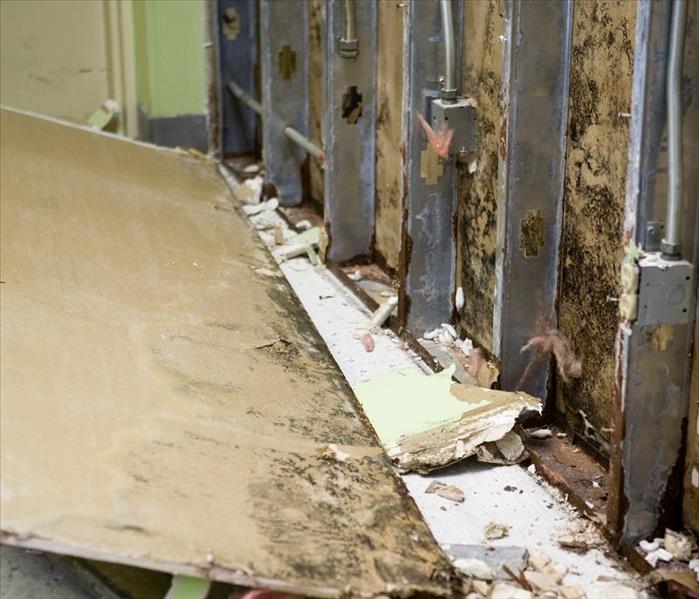 When you discover signs of water damage, rely on SERVPRO to resolve the hidden issue and restore the damage.
When you discover signs of water damage, rely on SERVPRO to resolve the hidden issue and restore the damage.
Call on SERVPRO for Quality Restoration Services after You Discover Water Damage
Water loss events in Atlanta require a specialized approach to ensure that the cleanup and remediation is thorough and meets industry standards. Failing to find and evacuate all the water or permitting building materials to remain damp leads to secondary damage. Our experienced team has the training and the experience to respond appropriately and comprehensively the first time.
Typical causes of water damage in Atlanta are not particularly dramatic and rarely make the news. For example, homeowners do not notice a small leak in the kitchen or bathroom, and the cabinetry or vanity conceal the harm done to walls or floors. Finally, saturated drywall or the ceiling below starts to bulge or stain, making it clear trouble lurks in hidden places. Our water damage remediation crews are familiar with this slowly accumulating damage and have effective strategies to find and resolve the leak before moving on to removing pockets of water and using our inventory of equipment to dry out the affected areas.
Water removal and drying are not always straightforward in these cases. The SERVPRO crew assigned to your home employs advanced technology like moisture sensors and thermal cameras that detect the water built up between walls, under floorboards, or in ceilings. Our IICRC certified technicians use powerful extraction tools to suction water out of recesses, removing small sections of walls, temporarily pulling off kick plates, or carefully breaking a hole in a ceiling for access if necessary. Water accumulating in several levels of flooring responds well to drying mats, and we may lift selected planks or other coverings to ensure the subfloor also has water released and removed.
Once our technicians eliminate the pockets of water, we concentrate on drying soaked building materials and fixtures. SERVPRO hosts a full inventory of industrial-strength air movers, heaters, and desiccant or refrigerant dehumidifiers to swiftly reduce the moisture content in walls, cabinets, floors, and more. Throughout the process we monitor the efficiency of our work with tools like thermohygrometers, keeping us apprised of the relative air humidity, remaining moisture in the structure, and temperature to inform our positioning of equipment and power level selection to dry out your home following industry standards.
SERVPRO of Southwest Cobb / Cascade looks forward to helping you untangle the mystery of hidden water damage, and then restore your home to preloss condition. Call (770) 739-2355 to schedule an evaluation and begin the process of water loss remediation.
Visit https://www.atlantaga.gov/ for more information on Atlanta.
Smyrna, GA 24 Hour Emergency Water Damage Service
8/25/2016 (Permalink)
SERVPRO of SW Cobb/Cascade is available 24 hours a day for water emergencies, large or small. When you are dealing with water damage, immediate action is crucial. A delay of just a few hours can greatly increase the severity of the water damage.
We Answer the Phone Ready to Help
Call Today – 770-739-2355
We understand that when you call us, you may be feeling confused, stressed, and vulnerable. You need an expert to guide you through this crisis. SERVPRO of SW Cobb/Cascade has the specific water damage training and experience to help you through this tough time. We specialize in water damage restoration—in fact, it's the cornerstone of our business.
What to Expect
When you call, we will ask several questions regarding your water damage emergency. These questions will help us determine what equipment and resources to bring, including how many trained SERVPRO Professionals may be needed.
Our SERVPRO Representative will ask several questions:
- Your name and contact information
- Your insurance information (if applicable)
- The street address of the water-damaged home or business
- When did the flooding or water damage occur?
- What caused the water damage (if known)?
- Is there electricity available (on-site)?
About SERVPRO of SW Cobb/Cascade
SERVPRO of SW Cobb/Cascade specializes in the cleanup and restoration of residential and commercial property after a fire, smoke or water damage event. Our staff is highly trained in property damage restoration. From initial and ongoing training at SERVPRO’s corporate training facility to regular IICRC-industry certification, rest assured our staff is equipped with the knowledge to restore your property.

 24/7 Emergency Service
24/7 Emergency Service

























